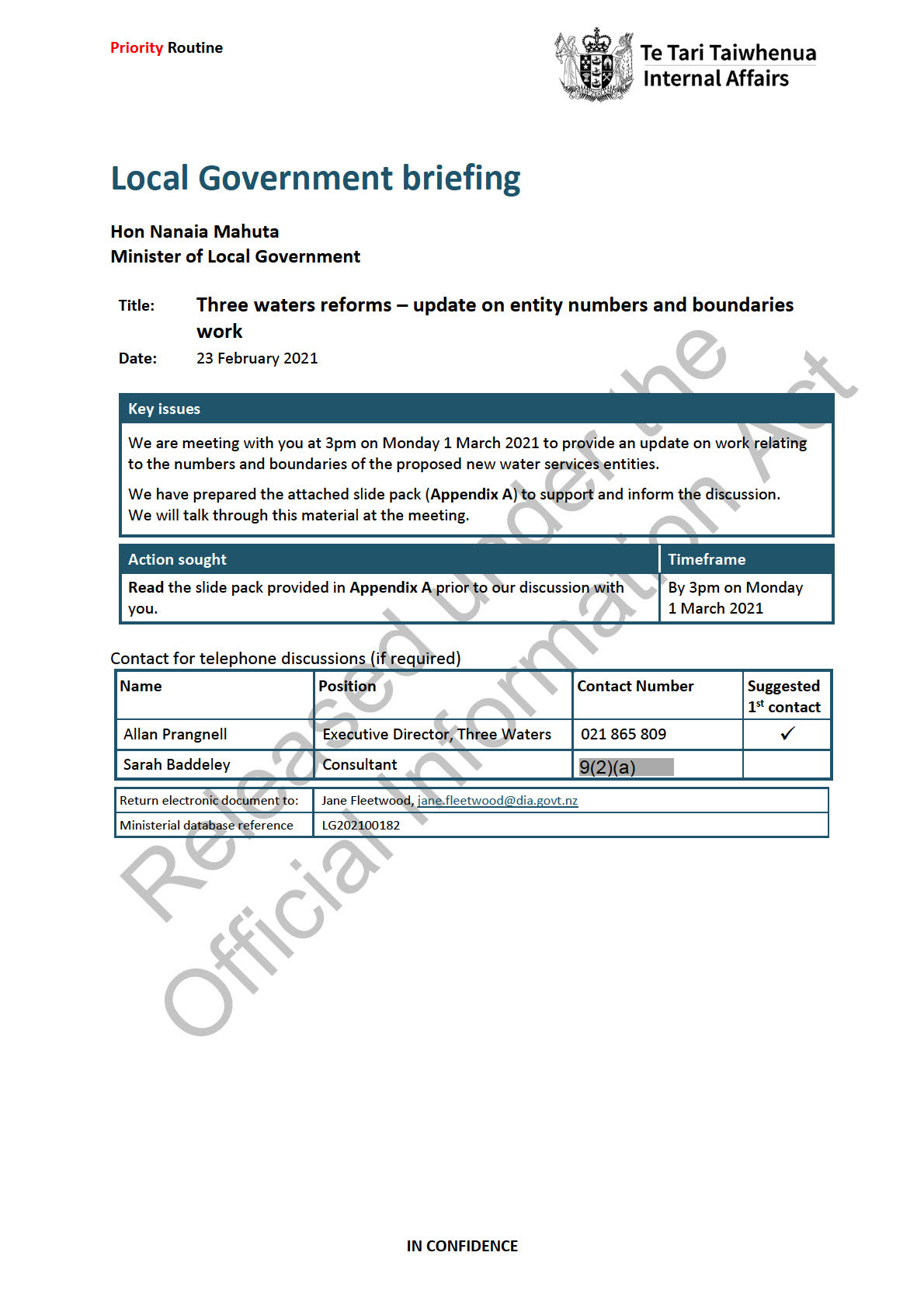
the Act
under
Information
Released
Official

The Department of Internal Affairs
Te Tari Taiwhenua
Purpose
1.
We are meeting with you at 3pm on Monday 1 March 2021 to discuss work relating to
the numbers and boundaries of water services entities.
2.
This briefing provides material to support and inform this discussion (
Appendix A).
We will talk through this material at the meeting.
Comment
3.
You have asked for an update on work relating to entity numbers and boundaries.
4.
At the meeting, we propose to provide you with:
4.1
an update on the Request for Information (RFI), and insights from that process;
4.2
an update on the numbers and boundaries analysis;
4.3
an overview of the Geographic Information System (GIS) decision support ool
that is being used to inform the analysis, including a ‘live run through’ o the
tool.
5.
The attached slide pack (
Appendix A) includes further information on these items.
6.
We would also like to talk to you about the interplay between the reform strategy
(voluntary, opt-out approach) and decisions about the numb rs and boundaries of
water services entities.
under the
Recommendations
7.
We recommend that you
read the slide pack provided at
Appendix A,
Yes/No
prior to our discussion with you about the numbers and boundaries of
entities work on 1 March 2021.
Released
Allan Prangnell
Executive Dire tor, Three Waters
Official Information Act
Hon Nanaia Mahuta
Minister of Local Government
/
/
IN CONFIDENCE
Page 2 of 3
The Department of Internal Affairs
Te Tari Taiwhenua
Appendix A: Slide pack – number and boundaries update, for meeting on 1 March
2021
Attached
the Act
under
Information
Released
Official
IN CONFIDENCE
Page 3 of 3
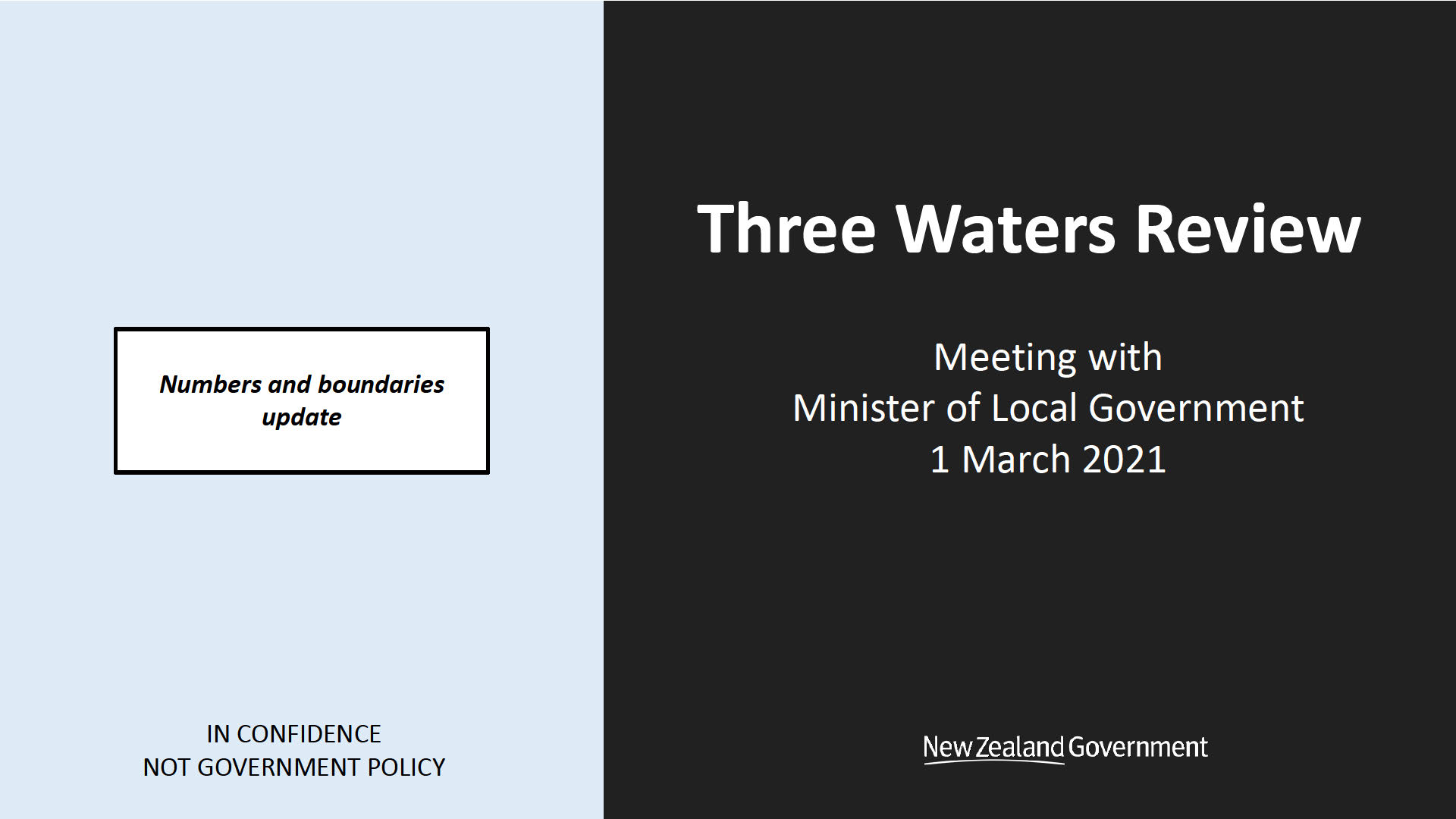
the Act
under
Information
Released
Official
Focus of session
the Act
1.
Update on the Request for Information (RFI), and feedback on process
under
2.
Update on the numbers and boundaries analysis
3.
Overview of Geographic Information System (GIS) decision support tool
(with a live run through)
Information
Released
Official
2
IN CONFIDENCE - NOT GOVERNMENT POLICY
Update on the RFI
• All territorial authorities have submitted a completed RFI (of either a simplified, financial y-focused RFI, or a more
the
complex, detailed financial and operational RFI)
Act
• This represents the single biggest data and financial picture of the three waters sector that has been undertaken
national y
• This has involved a significant effort across the 67 territorial authorities (10 of which opted into the more complex
under
request on a voluntary basis)
• The information wil enable analysis to better understand the
•
current state of the three waters related asset base
•
condition of the assets
Information
•
operating environment
•
commercial and financial arrangements
Released
•
forecast investment plans
•
potential impacts and advantages of reform on the local government sector
Official IN CONFIDENCE -NOT GOVERNMENT POLICY
3
Insights from the RFI process
the
• A significant effort in a short period of time (with conflicting priorities), the complexity of which had not been
anticipated in the sector
Act
• According to WICS – the smoothest, fastest process they have encountered
• The majority of territorial authorities have provided positive feedback about the process and understanding the
questions generated about their own assets
under
• Created a significant cohort of council officers who have experienced a step change in knowledge about their own
assets
•
Integrated asset management and finance knowledgeInformation
•
Disconnect between council officers and elected members
• Some councils have expressed concern about the basis for comparison to Scotland and the UK, given the difference in
the NZ sector. Processes are underway to address these issues – within the WICS work and independent reviews
Released
•
Application of British quality standards (and EU standards)
•
Coverage rates
Official
4
IN CONFIDENCE - NOT GOVERNMENT POLICY

the Act
under
Information
Released
Official
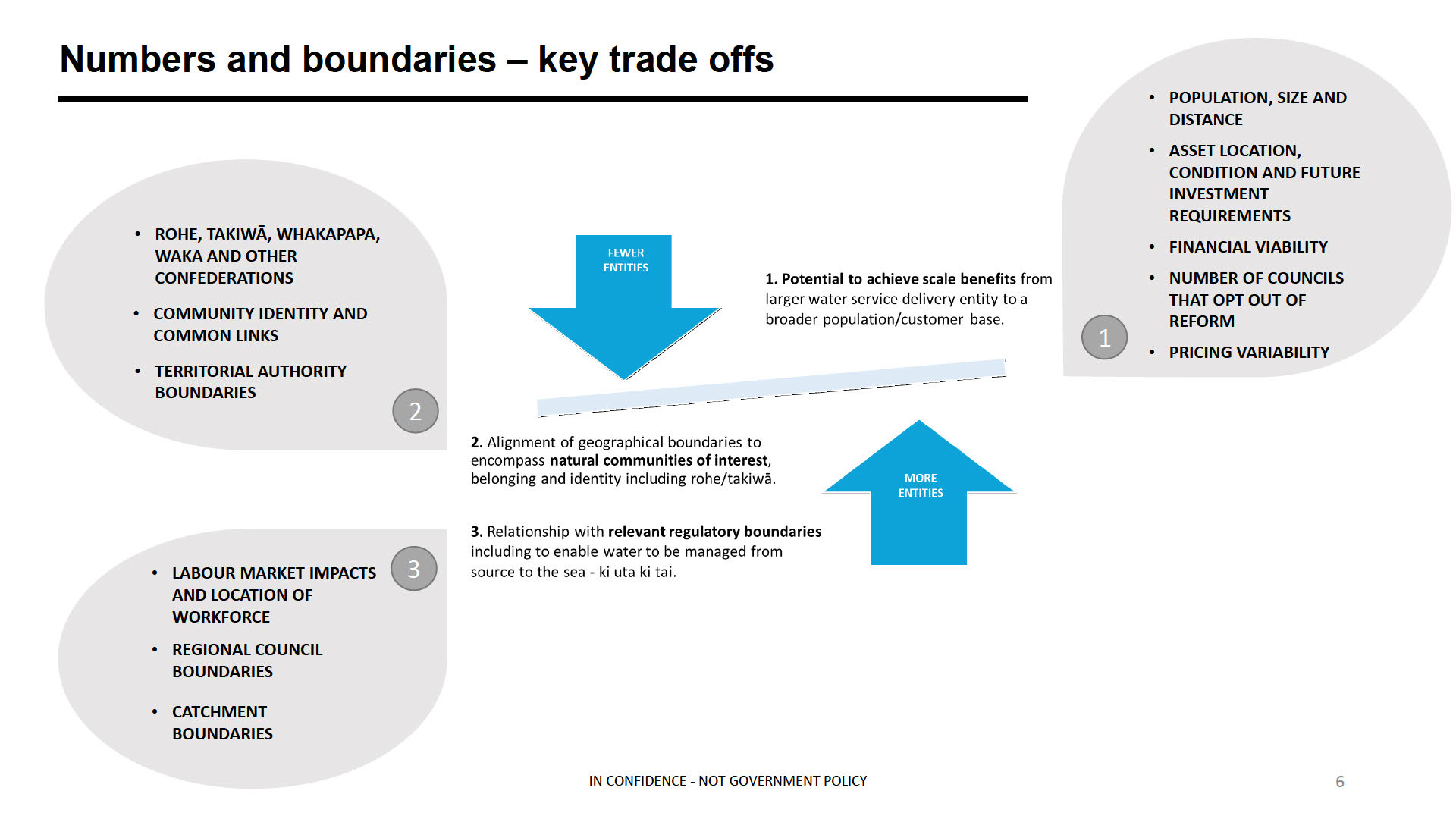
the Act
under
Information
Released
Official
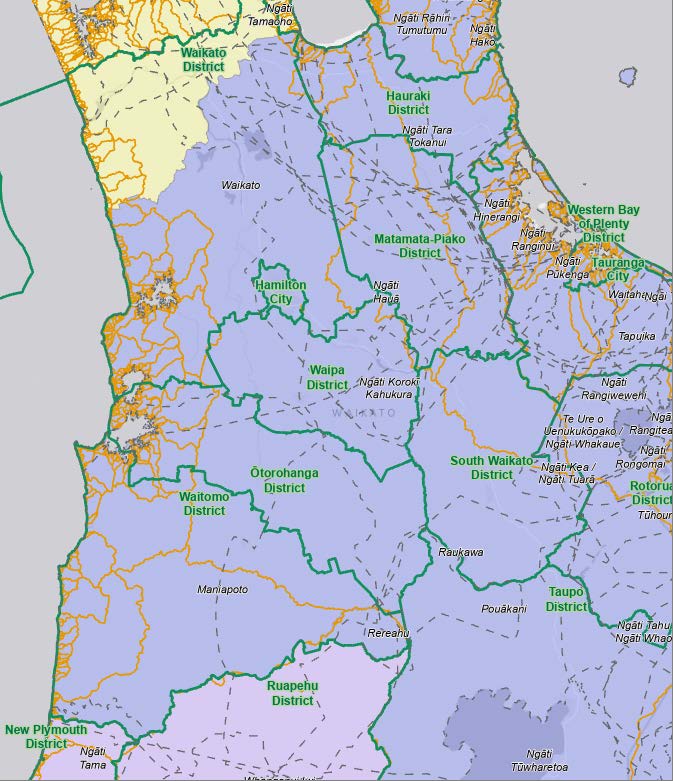 Our analysis is being informed by development of a GIS decision support tool
Our analysis is being informed by development of a GIS decision support tool
the Act
•
We are using GIS mapping to assist decision
making to reveal key areas of tension between
the various boundaries identified
under
• To date, our work is focusing on existing known
boundaries – however, it is expected that we will
overlap boundaries informed by WICS Phase
Two analysis
• Our analysis does assume that no individual
local authority will be split by a geographical
Information
boundary
• We will provide a demonstration in our meeting
Released
with you
Illustrative snapshot from GIS TOOL
Official
7
IN CONFIDENCE - NOT GOVERNMENT POLICY

the Act
under
Information
Released
Official
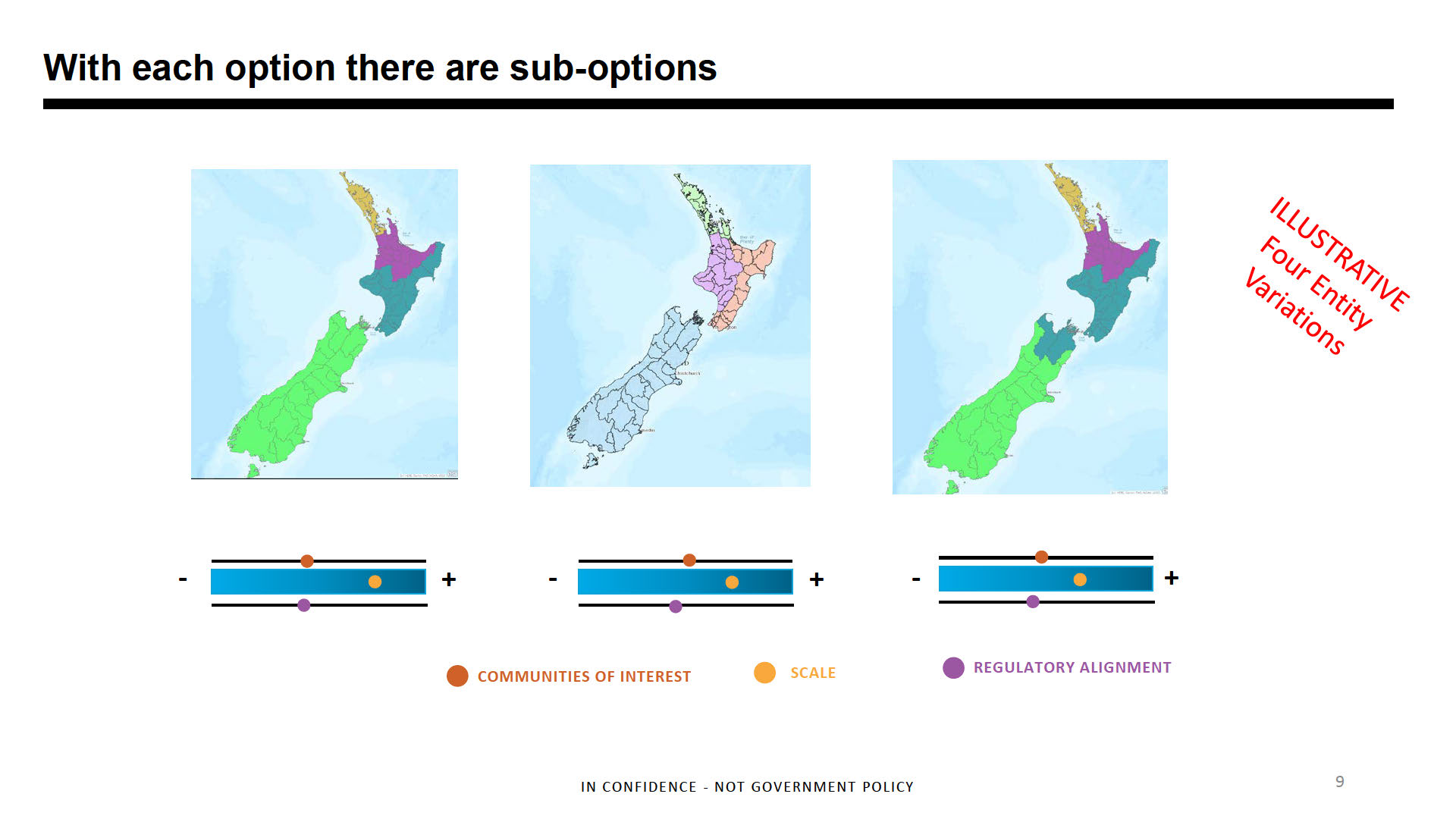
the Act
under
Information
Released
Official
Numbers and boundaries under an opt-out scenario
• The decision on the number and boundaries of entities is key to ensuring entities have a sufficient asset and
the
customer base to be financially sustainable, operate at an economically efficient scale, and so that prices are
Act
affordable for customers
• Evidence indicates each entity would need in the order of 500,000 to 1,000,000 connections to achieve minimum
efficient scale
• If a significant proportion of councils were to opt out, this could result in sub-scale entities. It may also make it more
under
difficult to achieve manage environmental outcomes at the catchment level
• A smaller number of entities would guard against the risk that opt-outs compromise the intended benefits of reform.
• Regardless of the number of entities, participation by the large metros (in particular Auckland and Christchurch) is
important to achieving the benefits of the reforms
• Preliminary analysis indicates:
Information
•
A voluntary (“opt out”) approach to reform would likely require two to three entities, and participation by nearly all major cities, to be
confident that entities will be of a sufficient scale Provided the large metropolitan councils participate, this approach could tolerate a
significant number of opt-outs from an economic/viability perspective
Released
•
A mandatory process could sustain up to six entities
• We wil provide further advice on this fol owing completion of further economic and financial analysis based on the
RFI data
Official
IN CONFIDENCE - NOT GOVERNMENT POLICY
10
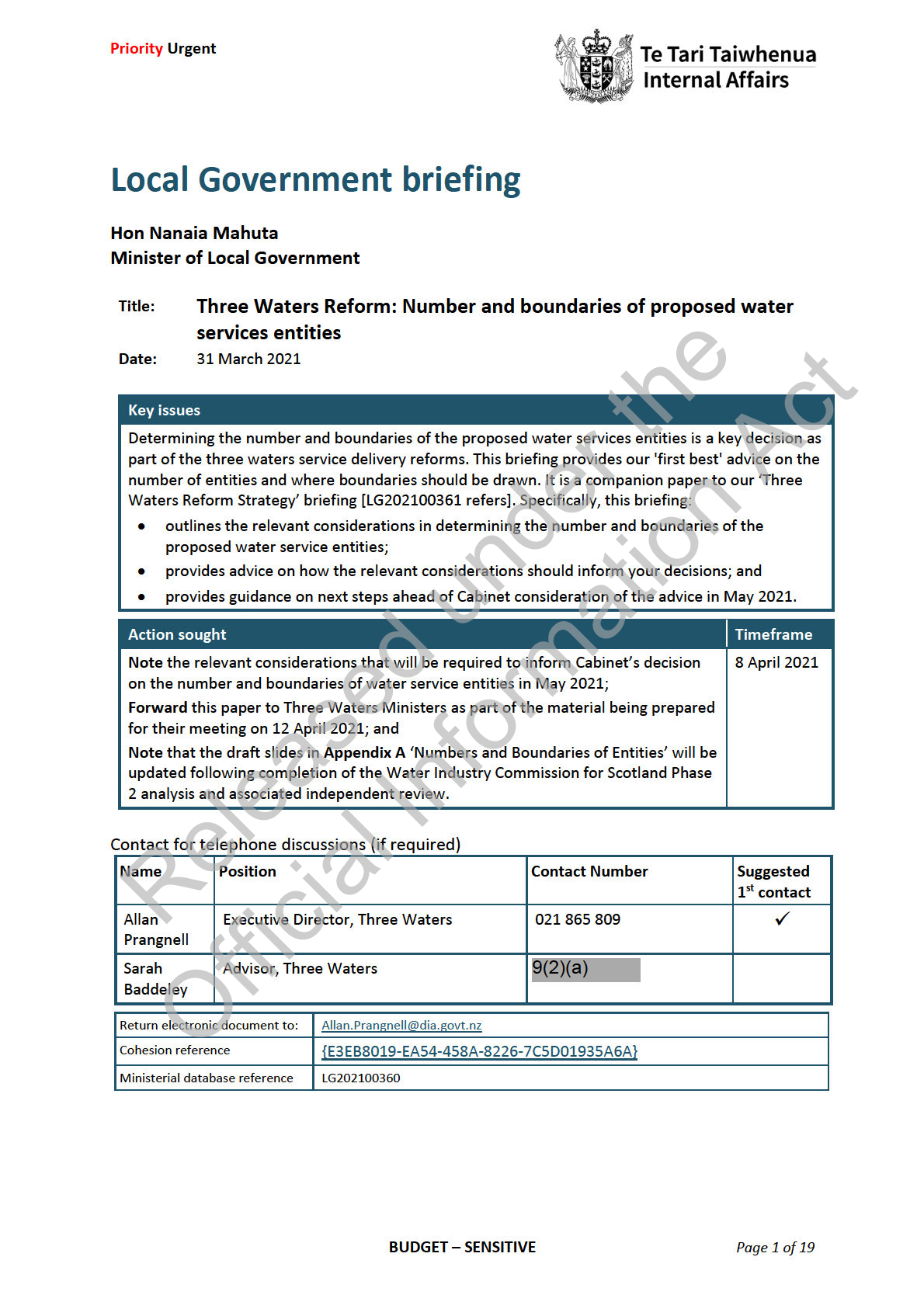
the Act
under
Information
Released
Official

the Act
under
Information
Released
Official
The Department of Internal Affairs
Te Tari Taiwhenua
9.
Provided that all territorial authorities participate in the reforms, three or four entities
would be of sufficient size to operate efficiently (provided each entity serves at least
600,000 to 800,000 and has a robust growth outlook). The final choice between these
two options is likely to be driven by which boundaries ministers consider will most
likely resonate with iwi/Māori and councils, taking into account communities of
interest.
10.
A key consideration is whether the South Island has its own entity. There is a related
choice regarding whether to have one entity for the whole of the South Island, or
whether to draw the boundary at the top of the Ngāi Tahu takiwā, with Tauihu joining
an entity spanning the lower North Island and upper South Island.
11.
Several options are set out in
Appendix A. While these options provide an initial
summary of the available choices for your consideration, we are not seeking decisions
until we have received the final analysis from WICS Phase 2, and the accompanying
the
independent review being conducted by FarrierSwier.1 This is scheduled to occur
before the meeting of Three Waters Ministers on Monday 12 April 2021 and material
Act
for that meeting will be revised to reflect these reports
Background
12.
New Zealand’s three waters system is facing a significant crisis and will continue to do
so without transformational reform. The latest economic analysis indicates that the
likely size of the infrastructure requirement facing local government water service
under
providers over the next 30 to 40 years, informed by the recent request for information
(RFI) process, could be in the order of $120 billion to $154 billion under one approach,
or $148 billion to $185 billion under an alternative approach. Meeting this investment
will be beyond the funding and operational capacity of most territorial authorities and
communities under current arrangements.
13.
New Zealand has a ighly fragmented and dispersed system, in which services and
infrastructure are delivered, operated, and paid for by a large number of providers –
including 67 territorial authorities, and thousands of private and community
Information
organisations and marae. Most of hese providers have a relatively small
population/customer base. There is wide variation in the quality of services provided,
the cost of provision o those services, and the price paid by consumers (customers
and atepayers).
Appendix B sets out a comparison of current and forecast connection
Released
numbers and cu rent estimated household costs across current territorial authority
service pr viders, based on information provided in the RFI submissions.
14.
Last year, Cabinet agreed to address this situation by reforming three waters service
de ivery arrangements to create large-scale water services entities. Reform would
enable la ger entities to realise scale efficiencies in the management and delivery of
Official
services and with sufficient balance sheet capacity to raise debt to fund these
investment requirements. This would enable delivery of the necessary infrastructure
1 FarrierSwier were engaged by the Department of Internal Affairs, overseen by Three Waters Steering
Committee, to provide an independent view on the methodology and assumptions underpinning a proposed
economic analysis to be undertaken by WICS.
BUDGET - SENSITIVE
Page 3 of 19
The Department of Internal Affairs
Te Tari Taiwhenua
upgrades more efficiently, and at lower cost to households, than would be possible
under current delivery and funding arrangements.
15.
Achieving the Government’s reform objectives will require entities to have a sufficient
asset and customer base to be financially sustainable, operate at an economically
efficient scale, and enable prices to be affordable and levels of service to be
comparable (or if not comparable, at least compliant with relevant standards and
expectations) across the country. However, to ensure that the new entities can
operate effectively within the three waters delivery system, it is important to consider
factors in addition to economic efficiency.
16.
Cabinet previously agreed [DEV-20-MIN-0099 refers] that, in relation to entity
boundaries, further advice is needed to consider:
16.1
scale benefits – including at least one very large urban centre within each
the
entity to ensure the full benefits of scale are achieved through a large network
and population base;
Act
16.2
communities of interest; and
16.3
relationships with other jurisdictional boundaries, including catchments.
17.
Iwi/Māori have also raised the importance of considering a Te Ao Māor expression of
kaitiakitanga through ki uta ki tai – the passage of water from the mountains and great
inland lakes, down the rivers to hāpua/lagoons, wahapū/estuaries and to the sea. Our
under
advice on boundaries has also been informed by our understanding of rohe/takiwā
boundaries.
Comment
The decision on number and boundaries is key to the reform’s success
18.
The decision on the number and boundaries of entities is key to ensuring entities have
a sufficient asse and customer base to be financially sustainable and operate at an
economically effic ent scale. This will ultimately enable the new entities to address the
significant inf astructure deficit, while ensuring prices are affordable for customers.
Information
This is particularly important given the scale of the likely investment challenge.
19.
Evidence ndicates each entity would need to serve a connected population of at least
600 000 to 800,000 to a hieve a minimum efficient scale. Below this point, entities
may find it difficult to fully realise the efficiency benefits that have been shown to be
Released
possible in other jurisdictions.
20.
Analysis by WICS highlights that companies in the United Kingdom serving populations
with less than 800,000 people are less efficient than larger companies (only managing
to realise between 10 and 50 per cent of the efficiency savings2 that the best
performing larger companies were able to realise following reform). That is not to say
Official
that entities serving populations of less than 800,000 are inefficient; rather they are
assumed to be less efficient than larger entities.
21.
A ‘first best’ approach would see all communities able to access the benefit of reform.
This implies full participation by all territorial authorities in the reform process. Re
9(2)(f)(iv)
2 Measured by looking at the extent to which regulated water utility companies have been able to close the
efficiency challenge issued by the regulator (Ofwat in England/Wales or WICS in Scotland) over the period of
1994-2002.
BUDGET - SENSITIVE
Page 4 of 19
The Department of Internal Affairs
Te Tari Taiwhenua
9(2)(f)(iv)
22.
The Government intends to significantly improve the safety, quality, resilience,
accessibility, and performance of three waters services, in a way that is efficient and
affordable for New Zealanders. This is critical for:
22.1
good public health and wellbeing;
22.2
good environmental outcomes;
22.3
economic growth and job creation;
22.4
housing and support for population growth; and
22.5
mitigating the effects of climate change and natural hazards.
23.
Achieving these outcomes requires entities to:
the
23.1
have a sufficient asset and customer base to be financially sustainable, and
Act
operate at an economically efficient scale, so that prices are affordable and
levels of service comparable; and
23.2
contain entire catchments within their boundaries to realise environmental
outcomes by enabling effective catchment planning and management of
associated infrastructure.
under
The RFI process has updated and expanded our understanding of the infrastructure
required to achieve well-performing and resilient three waters services
24.
In October 2020, the Department of Internal Affa rs issued the largest request for
information of the three waters service sector seen in New Zealand to date. The RFI
was issued to ensure that the economic and financial analysis required to provide
advice to Government and to local government decision makers was based on the
most up-to-date info mation from the territorial authorities themselves. It comprised
two parts:
Information
24.1
a general request to all territorial authorities to supply information that will be
used to inform advice and commercial and financial analysis; and
24.2
a detailed request to a sample of territorial authorities to supply further
information (in addition to that above) to enable more detailed economic
Released
analysis to inform the options for reform without placing significant demands
on the resources of all councils.3
25.
The RFI was comprehensive, with the detailed request requiring at least 14,000
individual da a points of information. The information related to an assessment of the
asset base, asset condition, operating environment, current commercial and financial
Official
arrangements, and forecast investment plans.
26.
The RFI was a significant first step in improving the quality of information available to
better understand the provision of water services. Previous policy work has been
hampered by poor quality and inconsistent data sets, meaning it has been difficult to
determine the state of infrastructure, likely future investment requirements, and the
3 The original sample comprised 37 local authorities from across the country, however a further ten local
authorities voluntarily undertook the more detailed request extending this detailed sample to cover
approximately 80% of the population.
BUDGET - SENSITIVE
Page 5 of 19

The Department of Internal Affairs
Te Tari Taiwhenua
performance of the sector. While the RFI provides an impressive start, there remains
significant room for improvement before the quality of information could be relied
upon by regulators. However, the information is of a sufficient quality to support policy
decisions, and indeed the poor state of information in the sector provides further
evidence in support of reform. Our confidence in the sufficiency of information to
support policy decision-making is informed by the state of information in other
jurisdictions like Australia and the United Kingdom prior to similar scale reforms.
Evidence of the infrastructure deficit
27.
In phase one, WICS identified a minimum need for $27 billion for enhancement of
infrastructure based on publicly available information. There was also the associated
investment required for asset replacement as it reaches the end of its seful life,
taking the total investment required between $70 billion and $96 billion.
the
Figure one: WICS Phase One
Act
under
Information
Released
28.
The Phase One analysis had several limitations, which we sought to address through
the RFI. I was based on out-of-date public information (contained in 2018-28 LTPs),
which did not cater sufficiently for population growth and made no allowance for
Official
resilience or climate change. The RFI was designed, in part, to address these
information deficiencies.
29.
At the time of the original analysis for Phase One, WICS’ modelling also suggested that
reported three waters asset values per connected person appeared to be low.4 This
was a contributing factor in our decision to undertake the RFI, as understated asset
4 Low asset values are likely to be a function of: incomplete records of assets; over-estimated asset lives; low
cost allowances for maintenance and replacement; and simpler less resilient and less compliant assets.
BUDGET - SENSITIVE
Page 6 of 19
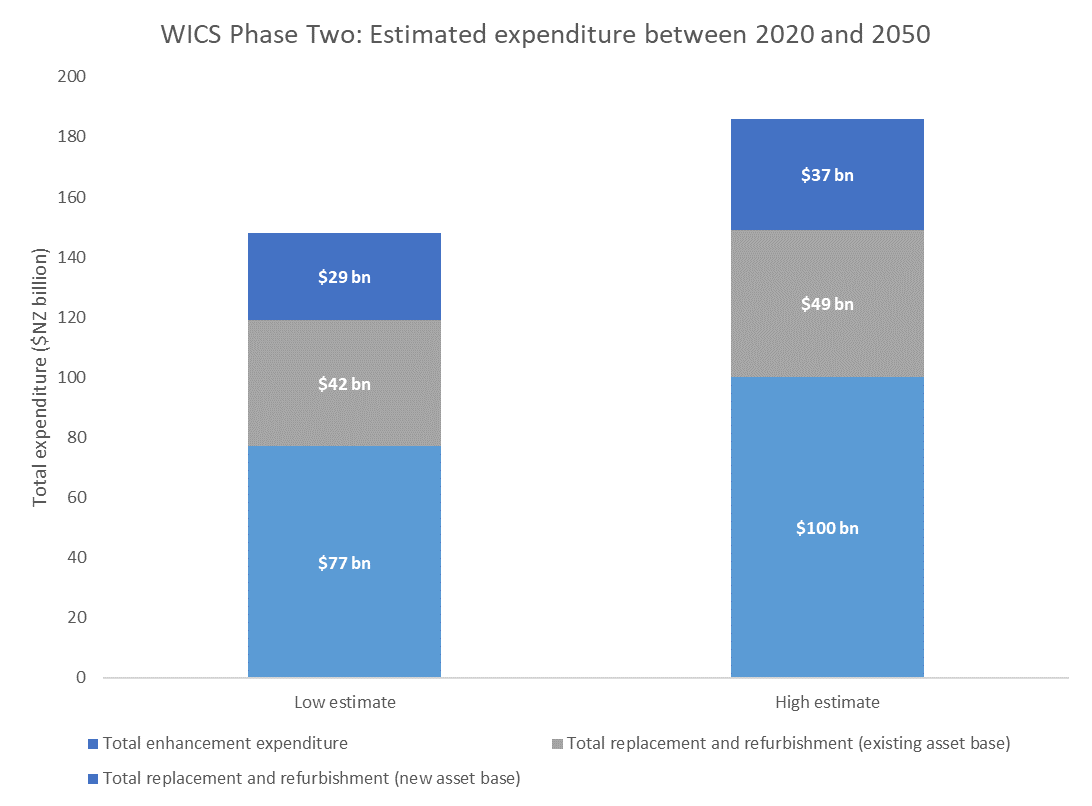
The Department of Internal Affairs
Te Tari Taiwhenua
values result in systematic under-funding of asset depreciation creating an ongoing
inability to adequately maintain the performance, condition, and risk profile of the
assets. This contributes, over time, to a deterioration of service levels, quality, safety,
and worsening environmental outcomes.
30.
Following completion of the RFI process, the estimated investment requirement has
increased from the Phase One estimate of $70 billion to $96 billion (in Phase One
shown above) to $120 billion to $154 billion under one approach, or $148 billion to
$185 billion under another (shown below). In arriving at these estimates, WICS used
four different approaches to estimating the infrastructure requirement, including a
cross-check against estimates provided by some local authorities through the RFI of
their view of the likely investment requirements in a financially unconst ained
environment. Each of these approaches provided reasonably aligned results.
Figure two: WICS Phase Two
the Act
under
Information
31.
To put this investment requirement in context, territorial authorities currently forecast
Released
investment of $1 5 bi ion annually or $45 billion over the next 30 years. The RFI
results, and associated economic modelling, indicate that in order to meet quality and
growth outcomes, investment spending would need to more than double over the
next 30 years (at current levels of efficiency).
32.
Th se numbers do not make additional provision for seismic resilience, climate change
Official
or responding to iwi/Māori expectations. These drivers for investment will have
different impacts in New Zealand relative to overseas and will vary between different
entity groupings. The absence of these investment drivers may mean that the total
investment required over time is likely to be an underestimate.
33.
To ensure that councils and government decision makers can be confident that the
WICS Phase Two analysis is sensitive to, and recognises differences in, the three waters
regulatory regime and industry practices between Scotland and New Zealand, officials
have also commissioned a review of the analysis by Beca Ltd.
BUDGET - SENSITIVE
Page 7 of 19
The Department of Internal Affairs
Te Tari Taiwhenua
Addressing the infrastructure deficit
34. A combination of factors has contributed to the local government sector now having a
better appreciation of the scale of the infrastructure deficit. Advice from territorial
authority officers through the long-term planning processes underway, combined with
a number of high-profile asset and network performance failures across the country
(across metro, provincial and rural areas), is contributing to a greater awareness of the
issue from elected members. At an officer level, the RFI has provided insight into the
kinds of information demands that would be required from future regulators.
35. Meeting the infrastructure deficit will require a combination of four available sources
of cost savings and funding:
35.1
Scale efficiencies – Enables more infrastructure to be delivered for the same
cost, as the increase in investment is offset by realising greater financing,
the
operating and capital expenditure efficiencies.
35.2
Debt/leverage – Utilised to finance investment, enabling costs to be spread
Act
over present and future generations.
35.3
Water pricing/revenue – Supports
the funding of investment o er time.
Relying solely on revenue to fund the infrast ucture deficit may mean pricing
objectives are not delivered and/or the transition is steep f r some
communities.
under
35.4
Potential Government financial contribution – Could provide targeted support
and also ensure the cost f debt is efficient for water entities and/or vulnerable
communities are not exposed to significant price increases.
36. Fewer entities (providing scale efficiencies) wil require less of the other three forms of
funding. This includes scale benefits that will accrue to individual households through
lower prices relative to the counterfactual The challenge in communicating the
benefits of the reform will be to outline the opportunities that can be delivered
through scale to address the infrastructure deficit, when compared to a counterfactual
in which cu rent evenue from c mmunities is insufficient to maintain and replace
Information
existing assets, let alone to address the future investment requirements.
37. We n te that the size of the investment deficit means reform does not imply lower
absolute prices in real terms. Rather, reform helps to avoid future price rises under the
current service delivery arrangements that would be unaffordable for many
Released
communities, particu arly those served in small, rural areas.
Scale efficiencies
38. Scale wil assist in meeting this investment challenge in several ways:
38.1
Financial efficiency – Increased financial capacity and capability with stronger,
Official
more flexible and resilient balance sheets, greater access to capital, and a more
reliable investment pipeline.
38.2
Operating efficiency – Improve operating efficiencies and lower operating
costs by consolidating administration and overhead costs and improving
organisational capabilities.
38.3
Capital efficiency – Improved asset management, including opportunities to
take a strategic and coordinated approach to consider infrastructure needs at a
larger scale and in the context of wider catchment outcomes.
BUDGET - SENSITIVE
Page 8 of 19
The Department of Internal Affairs
Te Tari Taiwhenua
38.4
Regulatory efficiency – Increased ability to manage regulatory burden,
minimise compliance cost, and enable quality and performance benchmarking.
International evidence on scale benefits
39. Drawing on evidence from the United Kingdom regarding the relationship between the
size of water services entities and the efficiency gains achieved post-reforms, WICS
assumes that scale increases on a logarithmic basis above a minimum size. This means
there is no scope for efficiency benefits below 60,000 population, but efficiency gains
are realisable at a diminishing rate from above this threshold, up to a maximum of
800,000, after which constant returns to scale are exhibited.
40. Outside of the WICS analysis, there is a wide range of international ev dence on the
benefits of scale. A range of studies find evidence of significant scale benefits, whereas
others are more cautious. Evidence of scale efficiencies in relation to wastewater
the
treatment are stronger than for drinking water provision.
41. In a New Zealand context, it is important to separate scale benefits that will likely Act
accrue to larger, professionally managed organisations from scale benefits that arise
from the provision of the water services (including network benefits). Both arguments
hold, but the first is difficult to separate from t e wider benefits of reform including
professional governance, specialist management, and good regulatory discipline that
are attributes of the broader system reform
42. Drawing on the broader evidence base, on balance, each entity would need to have in
under
the order of 500,000 to one million population served to achieve a level of efficient
scale to contribute to meeting the investment deficit.
Scale is not the only factor to consider in determining the number and boundaries of water
services entities
43. It is important that the potential to realise benefits from reform is not assessed on the
basis of scale benefits alone. The ability for the proposed entities to realise any
efficiencies will depend on several mportant pre-conditions. These pre-conditions
have been identi ied by WICS and the independent review of its methodology
Information
conducted by FarrierSwier They include:
43.1
clear policy direction for the water sector, as expressed for example through a
Government Policy Statement;
Released
43.2
entities with effective governance arrangements, able to attract and retain
appropriately skilled management;
43.3
new regulatory arrangements for water quality and improved environmental
outcomes are effective;
43.4
establishment of effective economic regulation (that is, entities face a hard
Official
budget constraint); and
43.5
entities with access to the necessary resources to fund the amalgamation
processes and over time make the required investment.
The impact of scale on geographic equity
44. The extent to which the Government wishes to pursue a form of national equity by
consumer type or equity by geographical region will affect decisions about the number
BUDGET - SENSITIVE
Page 9 of 19
The Department of Internal Affairs
Te Tari Taiwhenua
of entities. For example, wider tolerance for price variation allows for a greater
number of entities whereas low tolerance leads to fewer.
45.
In previous discussions, Three Waters Ministers have indicated a preference to
prioritise consistent national quality of service over consistent national prices. This is
consistent with our advice, given the balance of the policy challenges. A policy of
consistent national prices is likely to require one or two entities, which may be subject
to diseconomies of scale and concentrated risk of poor performance, as well as
challenges in reflecting communities of interest and achieving alignment with relevant
regulatory boundaries. Some variation in prices is natural given significant differences
in economic geography across the country, and desirable from the perspective of
achieving other outcomes (for example, providing incentives for resource conservation
in dry areas).
Other relevant considerations
the
Communities of interest
Act
46.
A key focus of the reform programme is ensuring that the new water services system is
responsive to community and consumer interests We have outlined a ange of options
designed to support the inclusion of the community voice in the new service delivery
system [LG202100219 refers]. These options include, among othe things, the creation
of a new Te Mana o Te Wai statement and response mechanism to support the rights
and interests of iwi/Māori.
under
47.
In analysing communities of interest, our focus has been on the geographical
expression of communities inc uding:
47.1
rohe/takiwā, common whakapapa and other confederations;5
47.2
the electoral boundaries of territorial authorities and regional councils; and
47.3
the labour market size and wo kforce location.
48.
At the scale of the likely entities proposed, consideration of factors relating to
communities of interest become most relevant if considering more than three entities.
Information
49.
We have attached a strong weighting to the probability that a community identity will
warrant consideration of a South Island entity (including potential for a Ngāi
Tahu/Tauihu takiwā app oach) on a standalone basis. This means that any
consideration of community of interest issues is likely to focus on how these interests
Released
manifest in the North Island, and relatedly, how these impact on the consideration of
entity boundaries.
Relevant regulatory considerations
50.
Our analysis has been informed by extensive GIS mapping, integrating physical
Official
boundaries, with catchment, rohe/takiwā and regulatory boundaries. Regulatory
boundaries have been defined widely to include administrative boundaries as they
relate to regional council boundaries, Waka Kōtahi boundaries for transport planning
and investment, current district health boundaries and some other government agency
relationship boundaries such as Te Puni Kōkiri.
51.
Our view, and that of other stakeholders including members of the Three Waters
Steering Committee, is that priority should be accorded to catchment boundaries.
5 This analysis has been informed by the Te Kahui Māngai directory managed by Te Puni Kōkiri.
BUDGET - SENSITIVE
Page 10 of 19
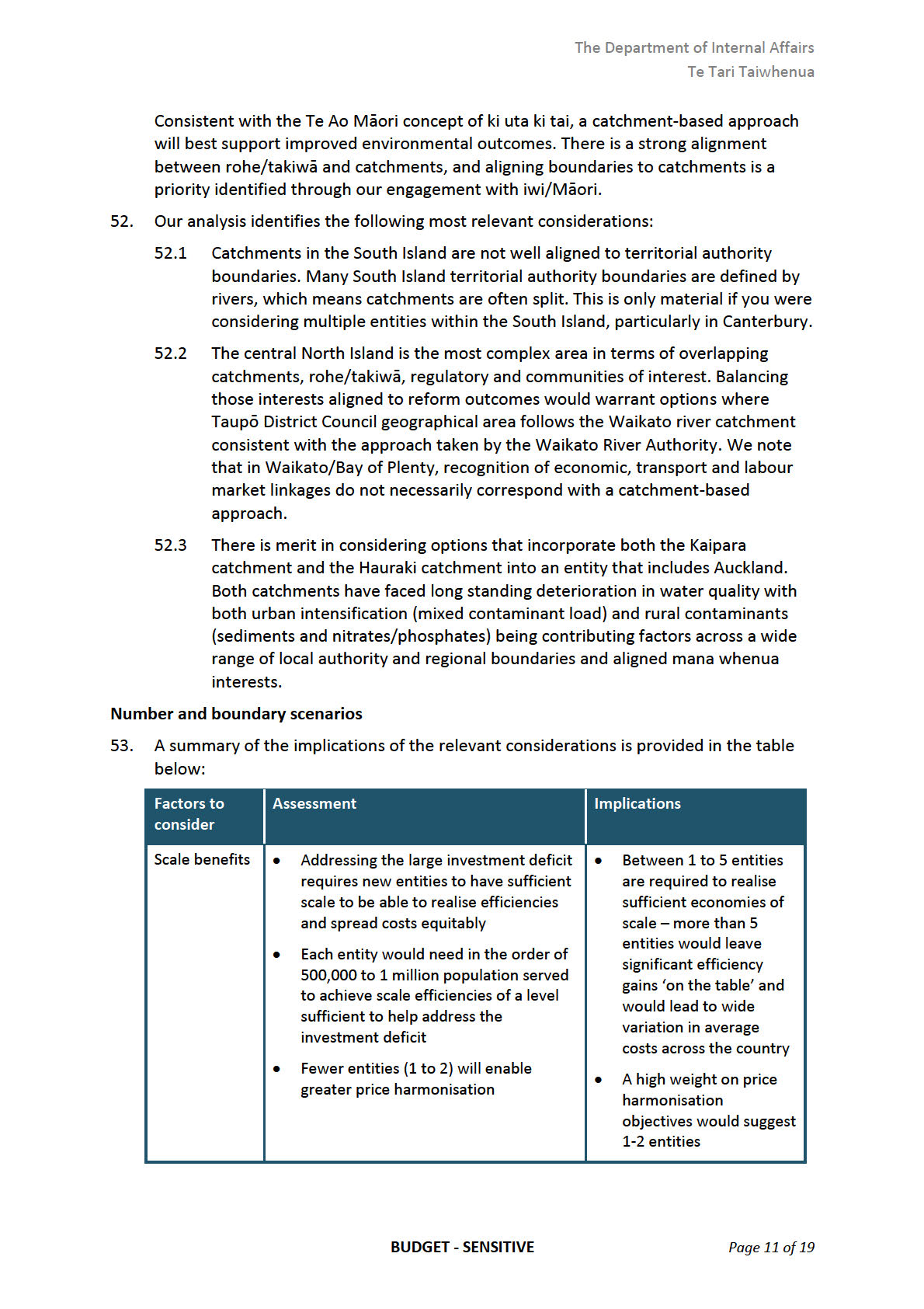
the Act
under
Information
Released
Official
The Department of Internal Affairs
Te Tari Taiwhenua
Communities
Strong community identity for South
South Island (including
of interest
Island
potential for a Ngāi
Tahu/Tauihu takiwā
Economic communities of interest
approach) likely to
including labour market and
require a stand-alone
infrastructure links are relevant and
entity
sometimes at odds with the catchment-
based approach
Community of interest
considerations more
At the scale of the entities, we are
relevant when
considering – common whakapapa
considering 3 or more
becomes more relevant than
entities
rohe/takiwā
Relationships
Catchments have become the most
Bo ndar es should be
with other
important of physical considerations.
situated along
the
jurisdictional
Consistent with ki uta ki tai,
catchment boundaries
boundaries
environmental outcomes benefit from
Act
Avoid splitting local
a catchment-based approach
authority boundaries to
Regional Council boundaries and
prevent a ding further
rohe/takiwā align with catchments
complexi y to the system
Some local authority boundari s have
boundaries on rivers, and should be
external boundaries for new entities
under
54. The final decision of the number and boundaries needs to be informed by the
finalisation of economic and financial advice Our first best advice, 9(2)(f)(iv)
is that the alance of the Government’s reform
objectives will be best met through a three or four entity scenario.
54.1
A three entity scenario would:
54 1.
Information
potentially access a greater range of efficiencies;
54 1.2 provide a greater potential uniformity of average costs per
househo d; and
54.1.3 likely require the South Island entity to be expanded to include
Released
Well ngton to achieve broadly comparable population density and
economic geography between the entities.
54.2
A four-entity scenario would:
54 2.1 Require a higher degree of tolerance for price variance over the long
term across the country (a graph of options by estimated household
Official
price impacts is included as Appendix C);
54.2.2 Provide a greater connection to the communities serviced by that
entity;
54.2.3 Enable the South Island (including Ngāi Tahu/Tauihu takiwā approach)
to be serviced by a single entity; and
54.2.4 Enable robust regulatory and performance benchmarking
BUDGET - SENSITIVE
Page 12 of 19
The Department of Internal Affairs
Te Tari Taiwhenua
55.
Ultimately, the choice between these options can be determined by which
configuration of number and boundaries is judged most likely to:
55.1
resonate with the iwi/Māori and territorial authorities impacted
55.2
best manage environmental outcomes;
55.3
ensure a smooth and effective transition; and
55.4
best position the new entities to be able to engage with willing partners from
establishment.
56.
In reaching our ‘first best’ advice on three or four entities, it is worth noting that we
have considered a single entity model, like those operating in Scotland and Tasmania.
We do not consider a single entity model to be optimal given the limited evidence of
significant additional scale economies above 800,000 connected customers, combined
with a limited ability to adequately benchmark without comparable performance data
the
A single provider could also provide potentially perverse ncentives in both labourAct
market (shallow talent pools) and procurement (monopsony tensions).
Engagement with the Three Waters Steering Committee
57.
The Steering Committee, at its recent meeting on 29 March 2021, considered advice
from officials that the three waters system reform objectives are best met through
either a three or four entity model.
58.
The Steering Committee broadly endorsed this general conclusion based on the
under
evidence presented to date, incl ding preliminary findings from the WICS Phase Two
analysis, subject to the final model btaining a high level of participation by territorial
authorities, especially the metropolitan councils. On balance, the Steering Committee
considered that a four en ity model was likely to have a broader appeal to the sector
than a three entity option, given greater connection to communities of interest.
59.
We note that the Steering Committee sees the determination of number and
boundaries of ent ties as only one aspect of the reform programme, and reserves the
right to consider the reform package as a whole.
Information
60.
The Steering Committee sought further consideration of several boundary issues
including for example the top of the South Island and the catchment approach in
Hauraki. It concluded that this issue would benefit from further engagement with the
affected councils and their neighbours, and with affected iwi/Māori. It noted the
Released
importance of completing the independent review of the analysis, which is underway.
Next steps
61.
Of icials are awaiting finalisation of the WICS analysis, as well as the conclusion of the
independent review by FarrierSwier. Notwithstanding this, we do not expect the
Official
finalisation of this advice for Three Waters Ministers to materially affect our
conclusions on the number and boundaries of entities.
62.
While we do not recommend taking final decisions until this work has been completed,
we consider it would be beneficial for you to discuss this advice, and your own views,
with Three Waters Ministers at their meeting on 12 April 2021. We recommend you
forward this briefing to Three Waters Ministers as part of the material being prepared
for that meeting.
BUDGET - SENSITIVE
Page 13 of 19

The Department of Internal Affairs
Te Tari Taiwhenua
63.
We have prepared some draft slides (attached as
Appendix A) that could be used as
the basis for your meeting with Three Waters Ministers on 12 April. These slides will be
updated once the final analysis by WICS, and the independent review by FarrierSwier,
has been concluded.
Recommendations
64.
We recommend that you:
a)
note the contents of this briefing; and
b)
agree to forward a copy of this briefing to Three Waters Ministers
Yes/No
as background reading in advance of their meeting on 12 April
2021.
the Act
under
Allan Prangnell
Executive Director, Three Waters
Hon Nanaia Mahuta
Information
Minister of Local Government
/
/
Released
Official
BUDGET - SENSITIVE
Page 14 of 19
The Department of Internal Affairs
Te Tari Taiwhenua
Appendix A: Draft slides for Three Waters Ministers Meeting
the Act
under
Information
Released
Official
BUDGET - SENSITIVE
Page 15 of 19
The Department of Internal Affairs
Te Tari Taiwhenua
Out of scope
the Act
under
Information
Released
Official
BUDGET - SENSITIVE
Page 16 of 19
The Department of Internal Affairs
Te Tari Taiwhenua
Out of scope
the Act
under
Information
Released
Official
BUDGET - SENSITIVE
Page 17 of 19
The Department of Internal Affairs
Te Tari Taiwhenua
Out of scope
the Act
under
Information
Released
Official
BUDGET - SENSITIVE
Page 18 of 19
The Department of Internal Affairs
Te Tari Taiwhenua
Out of scope
the Act
under
Information
Released
Official
BUDGET - SENSITIVE
Page 19 of 19
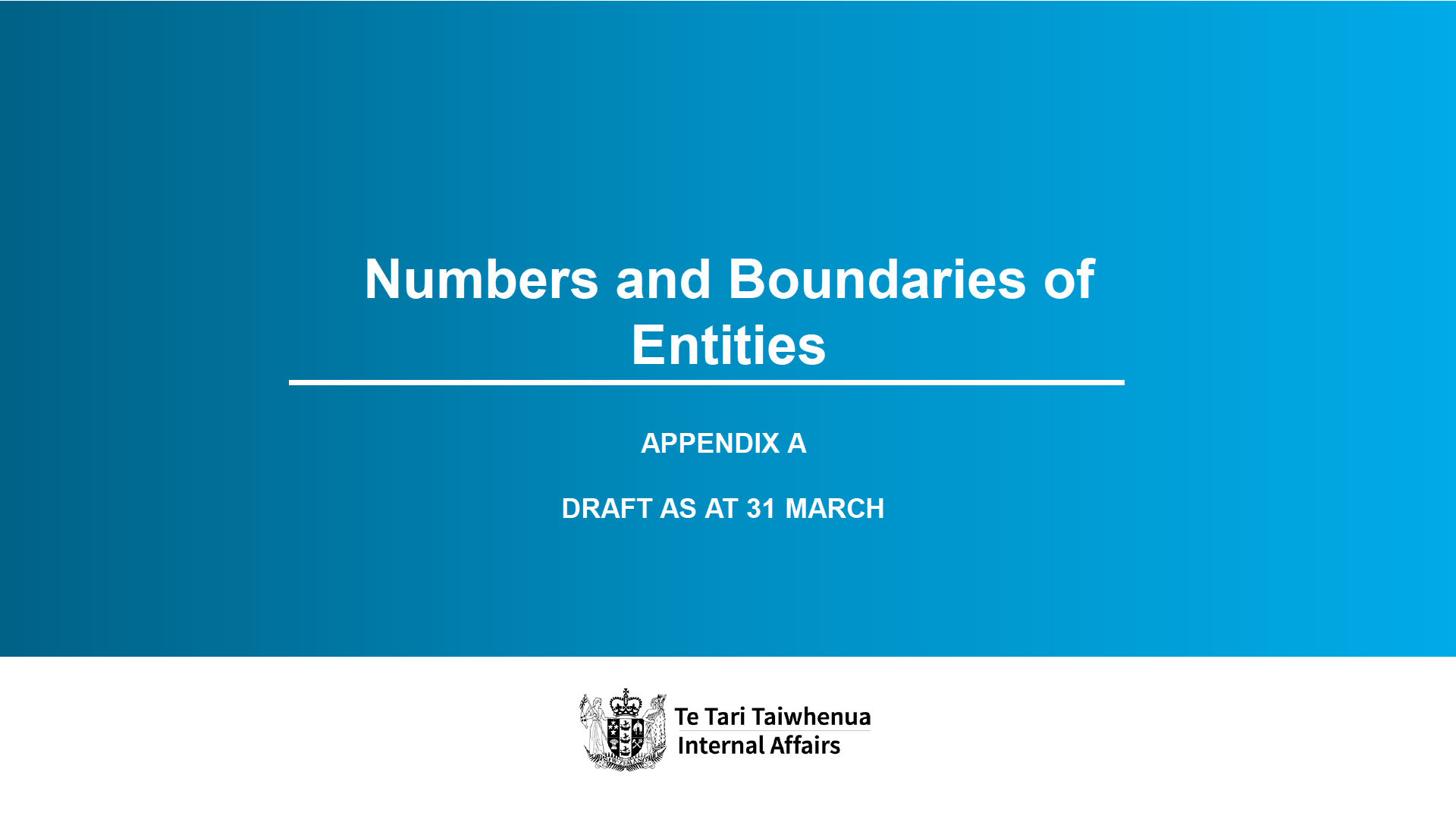
the Act
under
Information
Released
Official
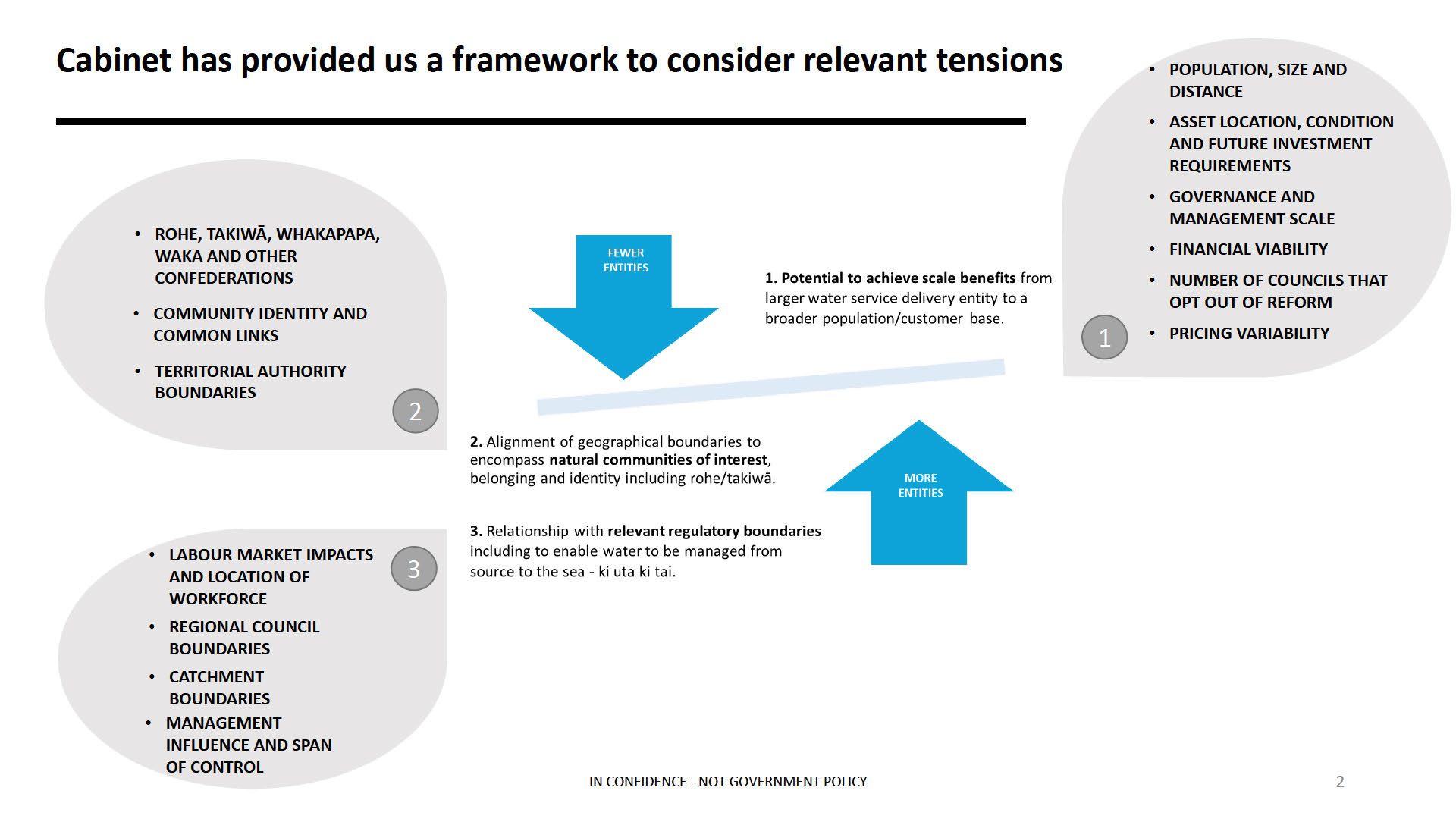
the Act
under
Information
Released
Official

the Act
under
Information
Released
Official
WICS has used a multi method approach to update their estimation of the infrastructure
deficit, and it is larger than originally estimated
• The RFI has updated earlier analysis that used local authorities’ own data from their LTPs. The updated information from the RFI has
increased the investment requirements from $70 billion - $96 billion to $120 billion - $154 billion for Approach 1, and $148 billion to
the
$185 billion for Approach 2.
Act
WICS PHASE ONE
WICS PHASE TWO
Approach 2: Based on Scotland regional data
Approach 1:
(preferred)
Low
High
Low
High
Low
High
under
Total replacement +
refurbishment (new
NZ$27 Bn
NZ$46 Bn
NZ$21 Bn
NZ$29 Bn
NZ$29 Bn
NZ$37 Bn
asset base)
Total replacement +
refurbishment
NZ$34 Bn
NZ$34 Bn
NZ$42 Bn
NZ$49 Bn
NZ$42 Bn
NZ$49 Bn
(existing asset base)
Total enhancement
NZ$8 Bn
NZ$16 Bn
NZ$57 Bn
NZ$77 Bn
NZ$77 Bn
NZ$100 Bn
expenditure
Information
Total investment*
NZ$70 Bn
NZ$96 Bn
NZ$120 Bn
NZ$154 Bn
NZ$148 Bn
NZ$185 Bn
*Numbers may not add due to rounding Released
• Current council spend is forecast $1.5bn annually or $45bn over the next 30 years.
• The more conservative estimate would still require significant investment and an increase in sector capacity and capability
to meet quality and growth outcomes - spending will need to more than double over the next thirty years.
Official
IN CONFIDENCE - NOT GOVERNMENT POLICY
Observations about the size of the infrastructure deficit
• BECA are in the process of assessing the WICS estimate using domestic expertise.
the Act
• Feedback from RFI de-brief sessions has been broadly accepting of the data.
• Some territorial authorities have raised concerns about the scale of the
investment deficit (predominately Canterbury) and how the RFI is being applied to
under
economic and financial analysis.
• However, other feedback from other territorial authorities has been positive.
Territorial authorities are, by-and-large, beginning to acknowledge this by
significantly increasing the amount of planned investment they are intending to do
Information
in their LTPs (collectively, this is up 50% on previous LTP).
• Issues related to under valued assets have resonated. We are hearing of instances
Released
of assets being revalued up and we understand that auditors are also paying
particular attention to understated asset values.
Official
IN CONFIDENCE - NOT GOVERNMENT POLICY
5
Our view is that scale efficiency benefits should be given priority in determining the
number of boundaries given the size of the investment challenge
• The size of the investment deficit, confirmed through the RFI process, means that achieving scale
the
efficiencies is critical to the reform’s success.
Act
• The most critical scale considerations are:
1. Financial capacity and capability
•
Opening balance sheet capacity
under
•
Management and governance competency
•
Investor confidence/certainty
2. Financial sustainability
•
Scale benefits in asset management, procurement and operational efficiency
•
Funding and pricing flexibility to address equity concerns (geographic and intergenerational)
3. Sector capacity/strategic workforce
Information
•
Sufficient scale to encourage strategic sector transformation, workforce planning, attraction of new providers, depth of management/governance talent most
likely achieved through more than two entities across the country.
4. Regulatory burden and benchmarking
Released
•
Ability to adequately benchmark without introducing costly regulatory burden to entities of insufficient scale most likely achieved by more than three entities
across the country.
Official
IN CONFIDENCE - NOT GOVERNMENT POLICY
6
What the evidence says around scale
• Drawing on UK evidence regarding the relationship between the size of water services entities and the efficiency gains
achieved post-reforms, WICS assumes that scale increases on a logarithmic basis above a minimum threshold of 60,000
the
customers – above this threshold, economies gains are assumed to increase at a diminishing rate before levelling off at
Act
the point where population served reaches 800,000 customers.
• Outside of the WICS analysis, there is a range of international evidence around scale benefits. A number of studies raise
find evidence of significant scale benefits, whereas others are more cautious. Evidence around the benefits of scale are
stronger for wastewater treatment than for drinking water.under
• In the New Zealand context, it is important to separate scale benefits that will likely accrue to larger, professionally
managed organisations from scale benefits that arise from the provision of the water services (including network
benefits). Both arguments hold, but the first is difficult to separate from the wider benefits of reform including
professional governance, specialist management, and good regulatory discipline that are important elements of the
broader system reform.
Information
• On balance, evidence indicates each entity would need in the order of 500,000 to 1,000,000 population serviced to
achieve efficient scale. Below this point, there are efficiency challenges.
Released
• FarrierSwier is currently providing independent review of this analysis.
Official
7
IN CONFIDENCE - NOT GOVERNMENT POLICY

the Act
under
Information
Released
Official
A range of scenarios for 1-4 entities
the
A range of scenarios
Projected Average Household Bills in 2050 (excluding inflation)
Act
have been run, to
$3,500
consider amalgamation $3,000
benefits and
estimations of
$2,500
under
household cost impacts $2,000
by 2050 as a proxy.
$1,500
Entity 1
Entity 2
This focuses on the
Entity 3
$1,000
Entity 4
range in end household
Information
impacts in 1-4 entities.
$500
$0
Released
S8: 2
S9: 2
S14: 4
S5 3 entities:S6 3 entities: S7 3 entities S2 4 entities:S3 4 entities:S4 4 entities:
S15 4
S19 4
entities:
entities:
entities:
Auckland
Hauraki
(WICS 6)
North Island Latitudinal Top of South entities: 2
entities: 2
Taupo North North and
North of
separate
approach
Split
split
(WICS 5)
on North 2 on North 2
(WICS8)
South
North with
on South
on South
Islands
all of South
(WICS 11)
(WICS 15)
separate
Official
Based on preliminary analysis, first best would be three or four entities (one of which is
the South Island)
• We believe the balance of objectives is
best met through a three or four entity scenario.
the
• A four entity scenario would:
Act
• require a higher degree of tolerance for price variance over the long term across the country
• provide a greater connection to the communities serviced by that entity
• enable the South Island to be serviced by a single entity
•
under
A three entity scenario would:
• provide a greater potential uniformity of price over the long term
• likely require a South Island entity to include Wellington
• Ultimately the choice between these options can be determined by which configuration of number and
boundaries is judged most likely to resonate with the iwi/Māori and local authorities impacted, to ensure
Information
a smooth and effective transition and best position the new entities to be able to engage with willing
partners from establishment.
• It is worth noting that a one entity scenario will limit the ability to adequately benchmark and lack
Released
comparable performance data. It will also provide potentially perverse incentives in both labour market
(shallow talent pools) and procurement (monopsony tensions).
Official
IN CONFIDENCE - NOT GOVERNMENT POLICY
10
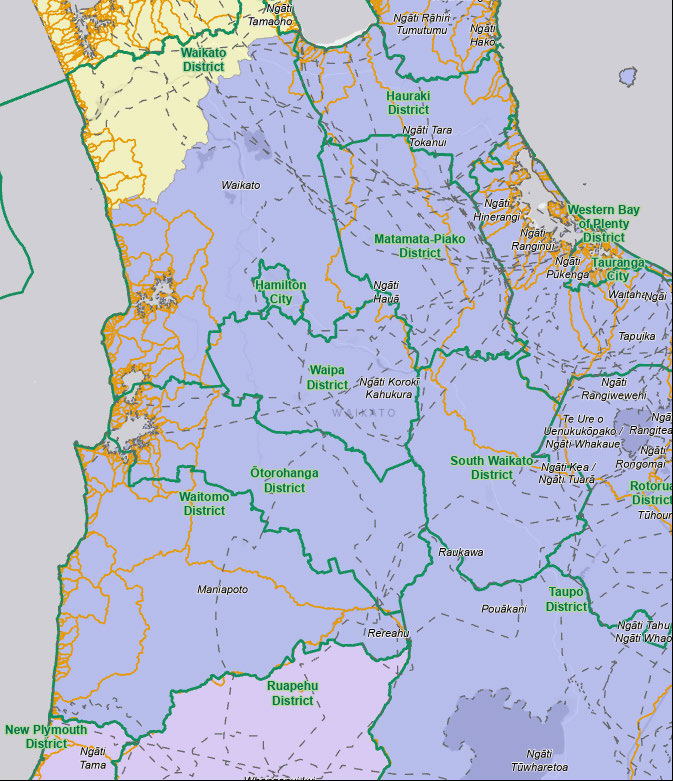 The other factors Government has asked us to consider, only become relevant if you are
The other factors Government has asked us to consider, only become relevant if you are
considering more than three entities
• Cabinet asked us to also consider communities of interest (including rohe/takiwā and
the
other regulatory considerations).
Act
• Other factors are only materially relevant when you are considering three or more
entities.
• We have undertaken extensive GIS mapping, integrating physical boundaries, with
catchment, rohe/takiwā and regulatory boundaries.
under
• This analysis identifies that the most critical to overall success is catchment boundaries:
• Rohe/takiwā strongly align with catchments
• Regional Council boundaries strongly align with multiple catchments
• At the scale of the entities we are considering – common whakapapa becomes more
relevant than rohe/takiwā.
Information
• We have assumed that no local authority boundary is separated (to prevent adding
complexity to the overall transition).Released
• Community of interest considerations are also only relevant in scenarios of entities
greater than three entities.
Figure: Example of GIS mapping undertaken
• We have assumed that the South Island (including potential for Ngāi Tahu/Tauihu
Official
takiwā considerations) will have a strong community of interest
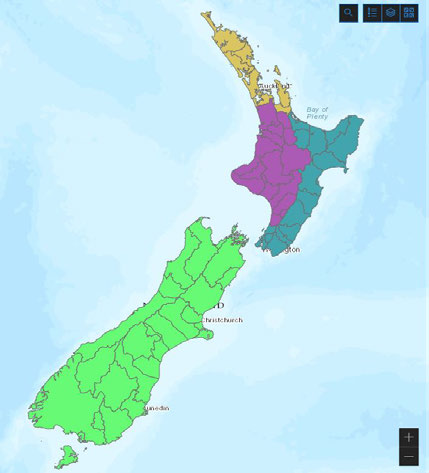
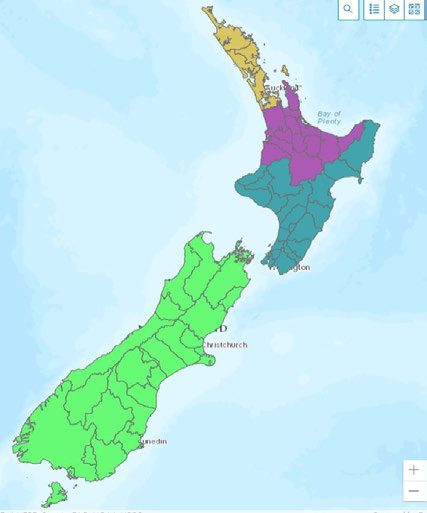 Key four entity options
Option - North Island
Option – Latitude Split
Key four entity options
Option - North Island
Option – Latitude Split
the
Split
Act
This option aligns slightly more
This option aligns
to traditional communities of
catchment and
interest.
rohe/takiwā more
closely than the other
option.
under
Information
Current
Current
Projected Average
Projected Average
Average
Average
Entity
Population served
Household Bill in 2050
Entity
Population served
Household Bill in 2050
Household
Household
(projected cash terms)
(projected cash terms)
Bill
Bill
Released
A
1,762,746
$1,120
$1,640
A
1,725,853
$1,100
$1,620
B
623,653
$1,140
$2,840
B
641,569
$1,370
$2,450
C
978,068
$1,030
$2,270
C
997,045
$920
$2,570
D
980,499
$1,110
$3,250
D
980,499
$1,110
$3,250
Official
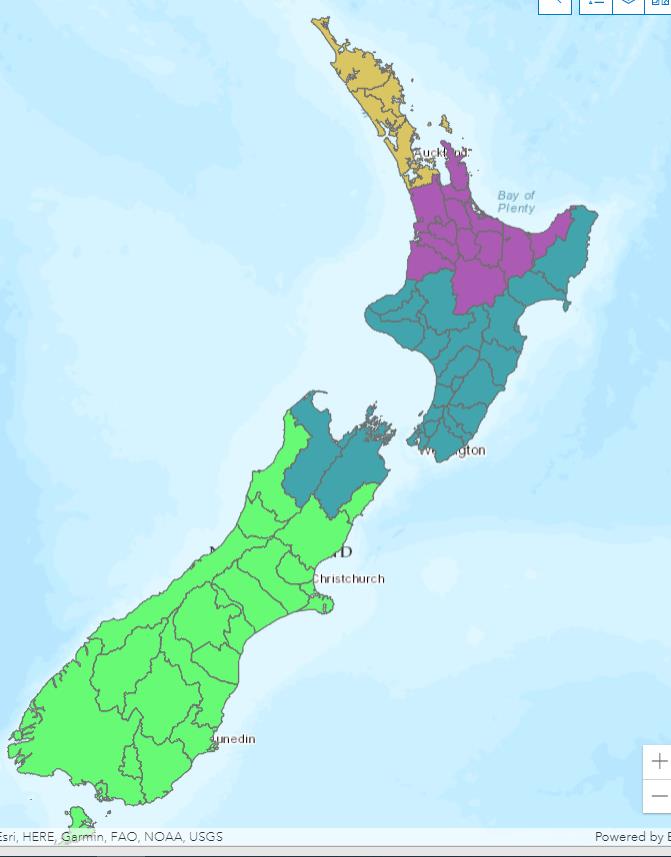
 Key four entity options continued
Option – Four entities
Key four entity options continued
Option – Four entities
top of the South
the
This option may align
Act
more favourably with
rohe/takiwā at the
bottom of the North
and top of the South
particularly between
Ngāi Tahu and Tauihu
under
hapū/iwi.
Iwi of Te Tau Ihu
Information
Current
Projected Average
Average
Entity
Population served
Household Bill in 2050
Household Released
(projected cash terms)
Ngāi Tahu Takiwa
Bill
A
1,725,853
$1,100
$1,620
B
641,569
$1,370
$2,450
C
1,113,194
$980
$2,600
D
864,350
$1,060
$3,330
Official
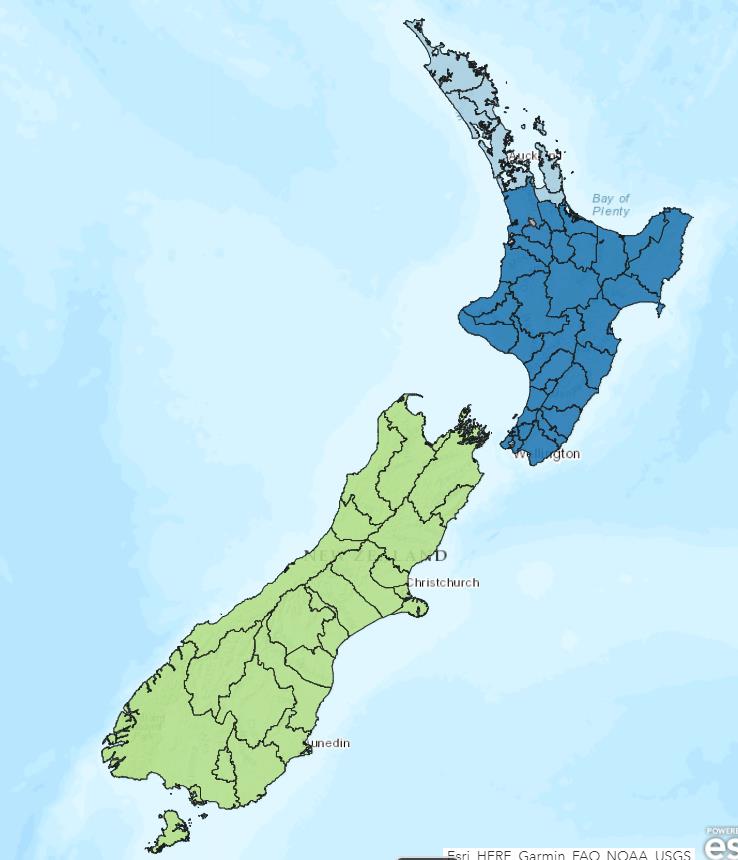
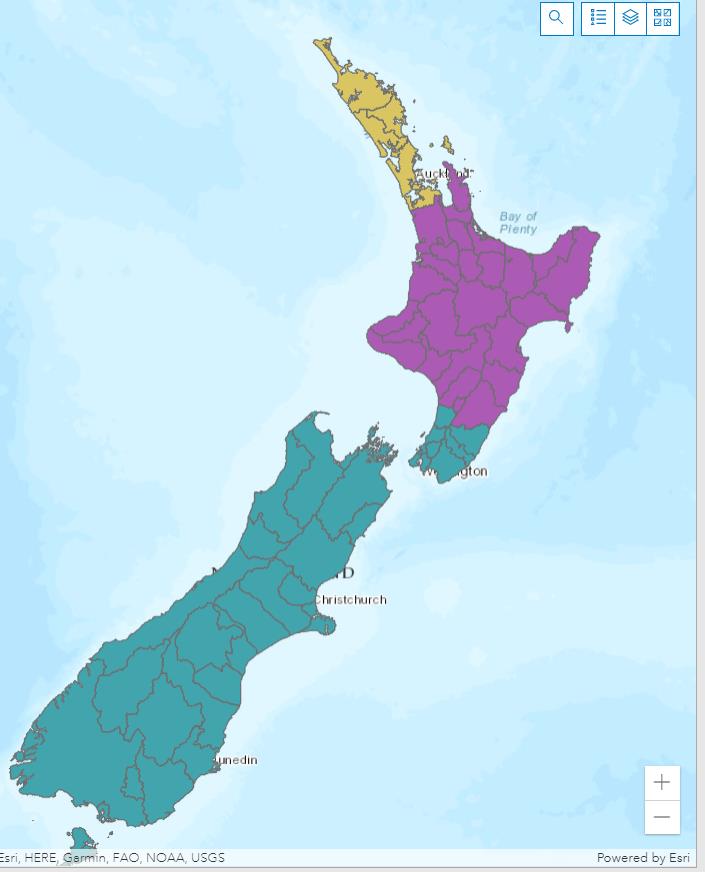 Key three entity options
Option – Three entities
Option – Three entities
Key three entity options
Option – Three entities
Option – Three entities
the
South Island includes
Wellington
Act
This option enables the
South Island to retain
This option provides the
its own entity
South Island with the scale
benefit offered by the
broader Wellington region.
under
Information
Current
Current
Projected Average
Projected Average
Average
Average
Released
Entity
Population served
Household Bill in 2050
Entity
Population served
Household Bill in 2050
Household
Household
(projected cash terms)
(projected cash terms)
Bill
Bill
A
1,762,746
$1,120
$1,640
A
1,725,853
$1,100
$1,620
B
1,601,721
$1,070
$2,480
B
1,093,984
$1,170
$2,680
C
1,525,128
$1,050
$2,830
Official
C
980,499
$1,110
$3,250
First best approach to support reform success
• A first best approach assumes all communities are able to access the benefit of reform.
the
• The Government has ambitions to significantly improve the safety, quality, resilience, accessibility, and
Act
performance of three waters services, in a way that is efficient and affordable for New Zealanders. This is
critical for:
• Good public health and wellbeing
• Good environmental outcomes
under
• Economic growth and job creation
• Housing and support for population growth
• Mitigating the effects of climate change and natural hazards
• Achieving these outcomes requires:
• Entities to have a sufficient asset and customer base to be financially sustainable, operate at an economically efficient scale, and
Information
so prices are affordable and levels of service comparable.
• Environmental outcomes are also dependent on containing entire catchments within the boundaries of entities (to enable
effective catchment planning and management of associated infrastructure)
Released
• We believe the balance of objectives is best met through a three or four entity scenario (if the South Island
is retained as a separate entity).
Official
IN CONFIDENCE - NOT GOVERNMENT POLICY
15
Next steps
• We are working through the preliminary advice from WICS Phase 2, and the RFI impact on the individual
the
financial position of each Council.
Act
• We are also awaiting independent review from FarrierSwier and BECA, FarrierSwier are bringing
particular focus to arguments related to economies of scale.
• We do expect this processes will:
under
• Confirm the direction of travel of advice included about the number of entities
• Provide much richer information about the impact on individual local authorities
• The Joint Steering Committee has broadly endorsed the approach, acknowledging that the decision on
number and boundaries sits within a broader reform context (including whether the process remains
voluntary and the size of any incentive package).Information
• We will recommend that Ministers await the final analysis before making final decisions regarding
number and boundaries and the reform strategy until this further analysis has been completed.
Released
Official
IN CONFIDENCE - NOT GOVERNMENT POLICY
16
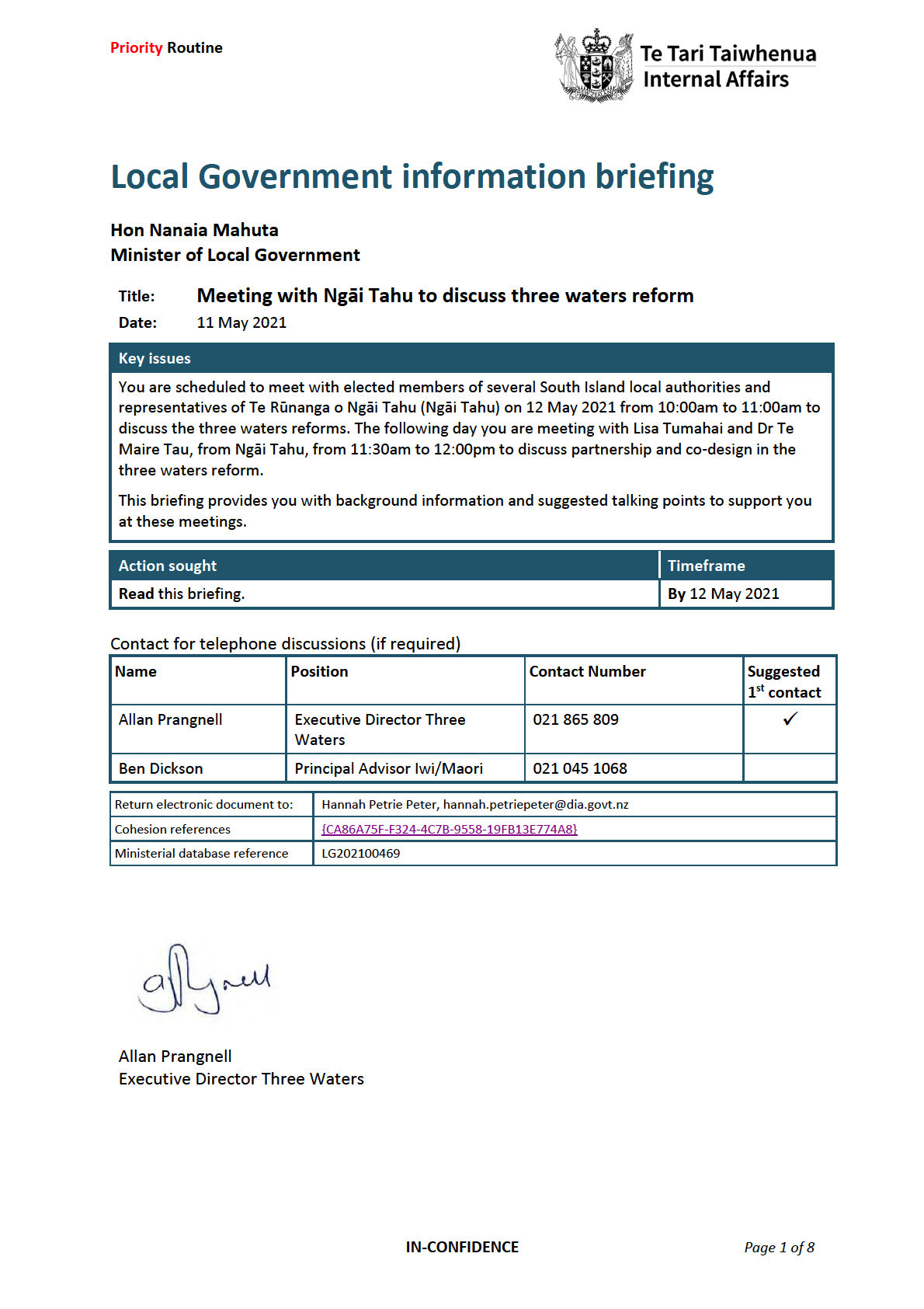
the Act
under
Information
Released
Official
Te Tari Taiwhenua
Department of Internal Affairs
Purpose
1.
You are scheduled to attend two meetings with elected members of several South
Island local authorities and representatives of Te Rūnanga o Ngāi Tahu (Ngāi Tahu). On
12 May 2021 from 10:00am to 11:00am you will meet jointly with several South Island
local authorities and representatives of Ngāi Tahu to discuss the three waters reforms.
2.
The following day you are meeting with Lisa Tumahai and Dr Te Maire Tau, from Ngāi
Tahu, from 11:30am to 12:00pm, to discuss partnership and co-design in the three
waters reform, as they relate to Ngāi Tahu.
3.
These meetings are an opportunity to have an in-depth discussion on the design of the
proposed water service entity for the South Island.
Background
4.
South Island local authorities and Ngāi Tahu have featured prominently in discussions
the
about three waters reform, including participating in several workshops through the
course of the reform programme.
Act
5.
9(2)(g)(i)
. Officials from the Department of Internal Affairs
(the Department) last met with Ngāi Tahu on 12 April 2021.
6.
We have discussed a number of issues regarding the reform programme with Ngāi
Tahu. We have been clear though that the three waters reforms provide an
under
opportunity to strengthen mana whenua influence over outcomes and the provision of
water, including through a more localised expression of Te Mana o Te Wai.
South Island water services entity design
7.
9(2)(g)(i)
Information
Released
Official
IN-CONFIDENCE
Page 2 of 8
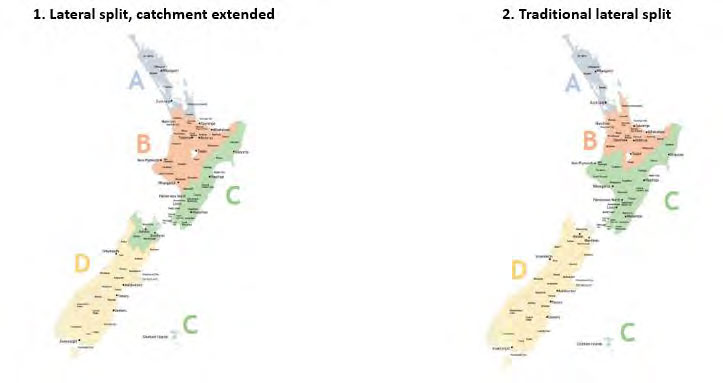

Te Tari Taiwhenua
Department of Internal Affairs
8.
Ngāi Tahu have expressed preference for the boundary of the South Island water
services entity to align with their takiwā. This is set out in
Te Runanga o Ngai Tahu Act
1996 – figure 2 below illustrates this boundary as the top of the South Island.
the Act
Figure 2. Ngai Tahu Takiwā boundary top of South Island
Outcomes under two variations of a four-entity scenario
9.
Ministers have indicated their preference for a four-entity scenario. Under this
under
scenario, officials are proposing two options (as seen below):
9.1
a lateral split that aligns with Whakapapa/takiwā at bottom of the North and
top of South island; and
9.2
a traditional lateral split that follows current regional boundaries.
Information
Released
Official
Figure 1. Boundary options for four-entity scenario
IN-CONFIDENCE
Page 3 of 8
Te Tari Taiwhenua
Department of Internal Affairs
9(2)(g)(i)
the Act
Points to note for joint local authority and Ngāi Tahu meeting, 12 May 2021
13.
We understand that South Island local authorities and Ngai Tahu are tentatively
supportive of the water service delivery reform proposals. However, they have
signalled in their engagement to date that there is a need to ensure a few matters are
delivered as part of the process, these include:
under
13.1 ensuring the design process for the water services entities is robust and that
councils and Ngāi Tahu play a role in the design process;
13.2 that clarity is achieved on residual chorine disinfection and durability of
exemptions to this;
13.3 that rangatiratanga is enabled;
13.4 the entity boundary will be defined by the Ngāi Tahu takiwa; and
13.5 the financial case is compelling in a local sense.
Information
14.
Appendix A contains talking points for the joint meeting on 12 May.
Points to note for the Ngāi Tahu meeting, 13 May 2021
Released
15.
Ngāi Tahu provided a letter, dated 7 May 2021, in preparation of this hui. They
outlined several matters that we expect to be raised, either in the joint local authority
and Ngai Tahu meeting or in the Ngāi Tahu only meeting. The following paragraphs
outline these matters.
Appendix B contains talking points for the meeting on 13 May.
Partnership and co-design
Official
16.
In our engagement to date, Ngāi Tahu have expressed a desire for a co-design
partnership for the development of a water services entity based around the Ngāi
Tahu Takiwā. 9(2)(g)(i)
17.
Ngāi Tahu are seeking agreement to paragraphs reflecting this approach be included in
the suite of Cabinet papers currently being developed.
IN-CONFIDENCE
Page 4 of 8
Te Tari Taiwhenua
Department of Internal Affairs
Out of scope
the
Content of the draft three waters Cabinet papers
Act
21.
Ngai Tahu have expressed the need to have access to draft versions of the relevant
Cabinet paper provisions as they are developed. They noted that, as we work more
closely, it would be useful for to have a shared understanding of the analysis and
thinking underpinning the fundamental parameters of the reforms will be crucial to
the quality and efficiency of co-design for Ngai Tahu Takiwā.
under
Summary of key points to note
22.
We anticipate that Ngāi Tahu:
22.1 will ask you for support at Cabinet for an entity that reflects the takiwā;
22.2 may request funding support to partner with the Department when designing
the entity; and
22.3 will ask to have visibility of draft Cabinet papers relating to the three waters
reform programme.
Information
Released
Hon Nanaia Mahuta
Minister of Local Government
/
/
Official
IN-CONFIDENCE
Page 5 of 8
Te Tari Taiwhenua
Department of Internal Affairs
Appendix A: Suggested talking points for joint 12 May meeting
Acknowledgements and three waters
• Thank you all for making the time to attend this meeting today.
• I would like to thank the local government sector and iwi/Māori for its input into the
Three Waters Reform programme to date.
• Particularly the chief executives and councillors who are participating in the joint
Three Waters Steering Committee. I appreciate the significant investment of time
and effort you are putting into this Committee, and the importance of your input to
the success of the programme.
The implications of water reform and resource management reform on the future of local
government
the
• Local government plays a crucial role in the wellbeing of all New Zealanders – there is
Act
now an opportunity for us to work together to strengthen its role in our communities
and country.
• As you are aware, the Government has announced a review into the Future for Local
Government.
• I want to take this opportunity to reiterate that this Government does not have a
under
broader local government amalgamation agenda.
• I can assure you that central government, in consultation with the sector, will be
engaging across the various aspects of our reform agenda to understand the
connections between the Three Waters Reform, Resource Management Act Review,
and Review for the Future of Local Government. This is to ensure that these
programmes of work all complement each other.
Concerns about maintaining community interests within bigger water providers
Information
• I appreciate that councils will want to ensure that ratepayers are protected following
the Three Waters reforms. I also recognise that iwi/hapū will want to ensure that
their Treaty rights and interests are upheld.
Released
• I would like to assure you that the reform process and design of the new water
entities will provide mechanisms to ensure this happens.
• The Select Committee process, as part of any associated legislation processes, will
provide councils, iwi/Māori and other interested parties with a further opportunity to
Official
have a say on the proposed water service entity arrangements.
Concerns about the potential scale and boundaries of the proposed water entities
• The Government is considering options and advice on key elements of the reform
package, including:
o
the number and boundaries of proposed entities;
o
entity governance arrangements; and
IN-CONFIDENCE
Page 6 of 8
Te Tari Taiwhenua
Department of Internal Affairs
o mechanisms that provide for community voice and influence.
• At this stage, Ministers are favouring the establishment of between three and five
water entities – these entities would each include at least one large urban centre.
Ownership of water assets and subsidising water assets in other regions
• This Government has been clear that water infrastructure must remain in public
ownership under any new service delivery arrangements. The proposed new entities
must include mechanisms to protect the publicly-owned nature of these entities now
and into the future.
• The reform would see a range of positive outcomes for councils and their
communities. For example:
o a move to more financially sustainable multi-regional entities with full
the
financial separation from councils;
Act
o creating debt headroom for councils to invest in other community priorities;
o improved efficiency of water service delivery, with benefits for regional
investment, jobs and productivity; and
o the advantages of scale, which means that smaller councils and communities
under
who are part of a larger multi-regional entity will be able to benefit from the
sharing of infrastructure or resourcing costs across a larger population base.
• The overall scale of these entities is crucial because without large entities sharing the
costs across all the communities it covers, smaller council ratepayers will bear a
disproportionate amount of cost for water services.
• In short, the greater sharing of costs across larger populations can be, the more
minimised the impact of the reforms will be on smaller communities.
Information
Ensuring fairness in the transition process
• I am equally mindful of anxiety about the scale and cohesiveness of the extensive
reform programme impacting the local government sector – particularly resource
management and three waters reform.
Released
• I expect fairness to be a key objective of the transition process, while delivering the
reform objectives.
• Any queries about the transition process can be directed to the Three Waters Team
Official
at the Department of Internal Affairs.
IN-CONFIDENCE
Page 7 of 8
Te Tari Taiwhenua
Department of Internal Affairs
Appendix B: Suggested talking points for 13 May Ngai Tahu meeting
Acknowledgements and Three Waters
• Thank you all for making the time to attend this meeting today. I thought yesterday’s
meeting was very productive and provided greater clarity for myself and officials on
the direction of the three waters reform for the South Island.
• Thank you for your letter in preparation of this meeting. I would like to thank Ngāi
Tahu again for its input into the Three Waters Reform programme to date.
South Island entity boundary
• I understand that you have expressed preference for the boundary of a South Island
water services entity to align with your takiwā.
Partnership and co-design
the
• I am pleased to hear that my officials have been working alongside you in the Act
development of the three waters reform proposals.
• I understand you have expressed a desire for a co-design partnership for the
development of a water services entity based around the Ngāi Tahu Takiwā.
• My officials have told me that paragraphs reflecting this have been included in the
suite of Cabinet papers currently being developed.
under
Out of
scope
Information
Released
Draft Cabinet Papers
• I understand you have expressed the need to have access to draft versions of
relevant Cabinet paper provisions as they are developed.
Official
• I think this would be useful to support the outcomes I am seeking from this reform.
IN-CONFIDENCE
Page 8 of 8
Eman Abdine
From:
Sarah Baddeley 9(2)(a)
Sent:
Friday, 30 July 2021 10:59 AM
To:
Eman Abdine
Subject:
OIA2122-0083 CALLAGHAN FW: Background information for Te Tai Ihu Councils - just FYI no
action required
Attachments:
wics-supporting-material-5-Council-outcomes-Te Tai Ihu.pdf; Three waters reform maps top of
the south island.pdf
Sarah Baddeley | Executive Director
MartinJenkins
the
9(2)(a)
Act
From: Sarah Baddeley
Sent: Monday, 12 July 2021 2:46 PM
To: '[email address]' <[email address]>; Pat Dougherty 9(2)(a)
Cc: Nick Davis <[email address]>; [email address]
Subject: Background information for Te Tai Ihu Councils ‐ just FYI no action required
Tēnā kōrua
under
I thought it helpful to provide you both with a little more background information ahead of discussions related to
the treatment of Te Tai Ihu councils likely to occur this week.
I have pulled out the council specific analysis for Te Tai Ihu Councils under the various amalgamation scenarios run
by WICS. Here I draw your attention to the attached and scenario 29 which was a whole of South Island entity, vs
scenario 30 which is the scenario preferred by Government which would see Councils in the top of the South Island
included in Entity C.
Information
With respect to those communities and council assets included in the grey zone of the map released (below), the
scenarios have assumed that all of Tasman District Council and Marlborough District Council’s assets (and debt) are
included in Entity C. This is largely because those communities impacted by the split below the Ngāi Tahu takiwā are
small and not material to the forecast of cost and investment by 2050. Not to say it is not very important for those
communities impacted. I also attach a couple of maps that may be of interest that outline catchment and landuse
Released
details for the area impacted by the takiwā boundary approach.
If you have any specific issues or advice on the discussion happening locally feel free to sing out.
Warm regards
Official
Sarah
1
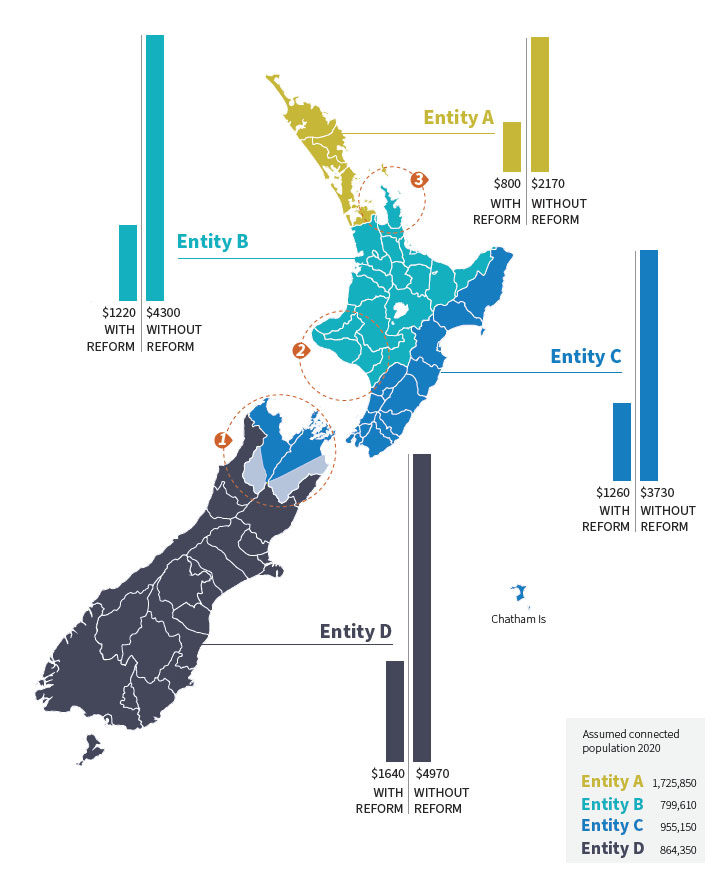
the Act
under
Information
Released
Official
2
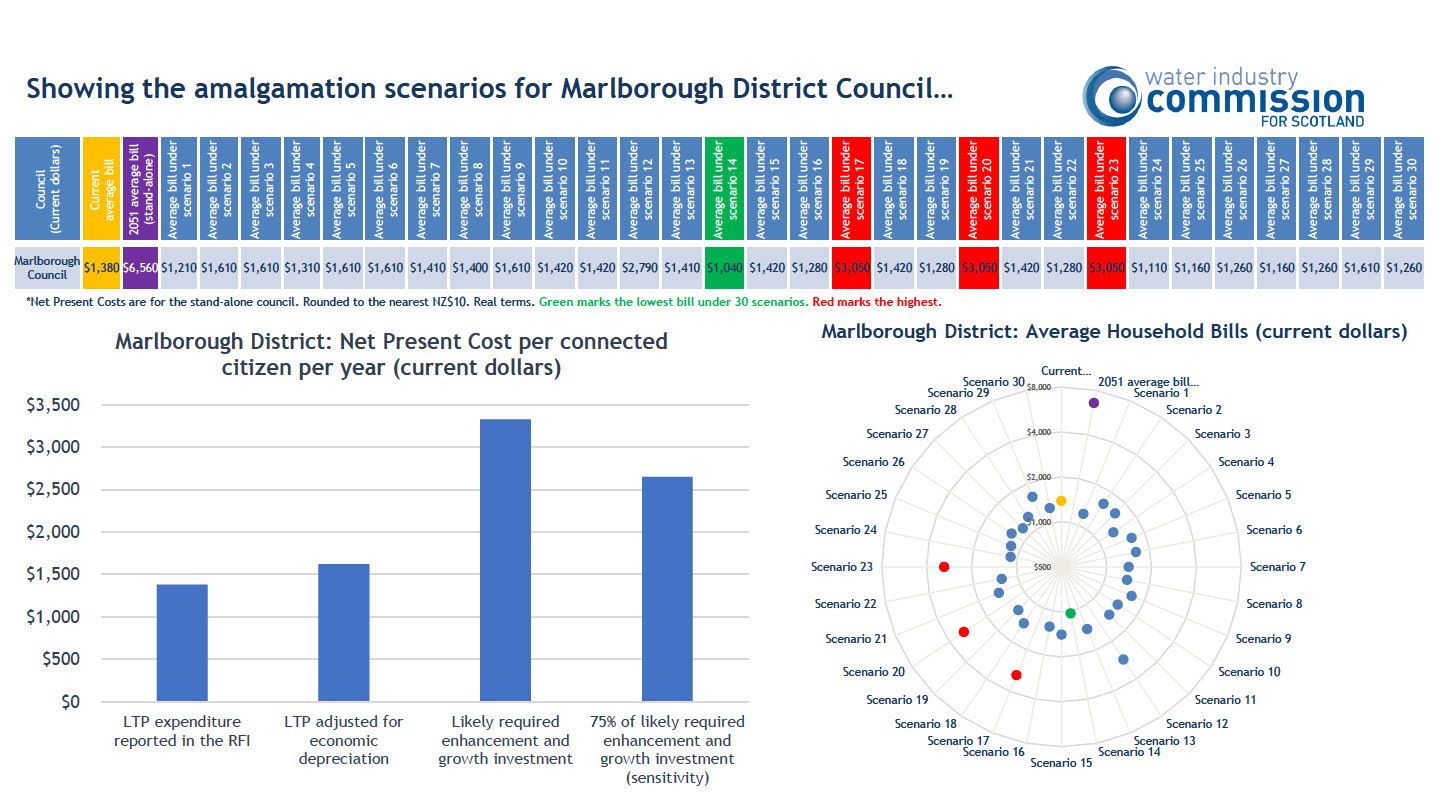
the Act
under
Information
Released
Official
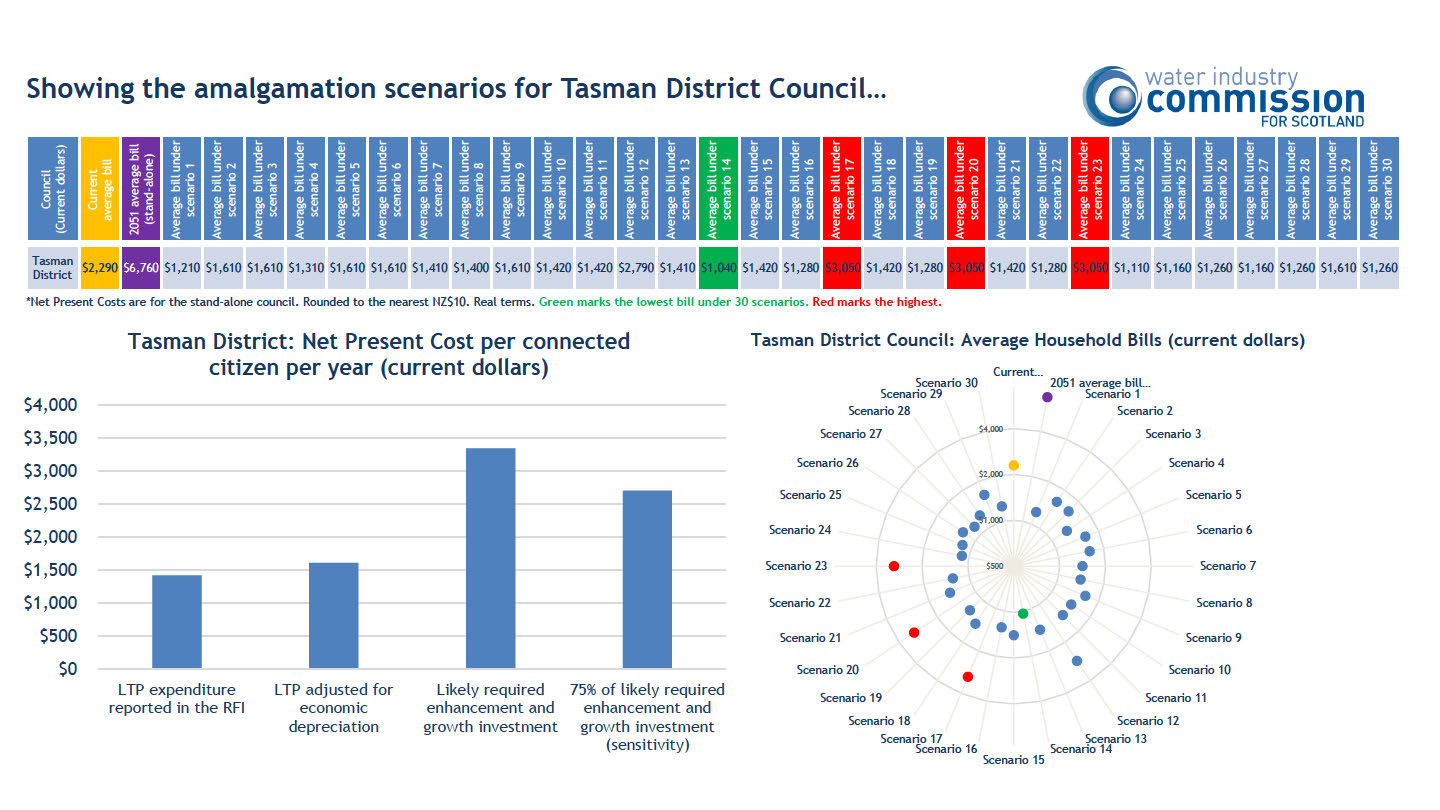
the Act
under
Information
Released
Official
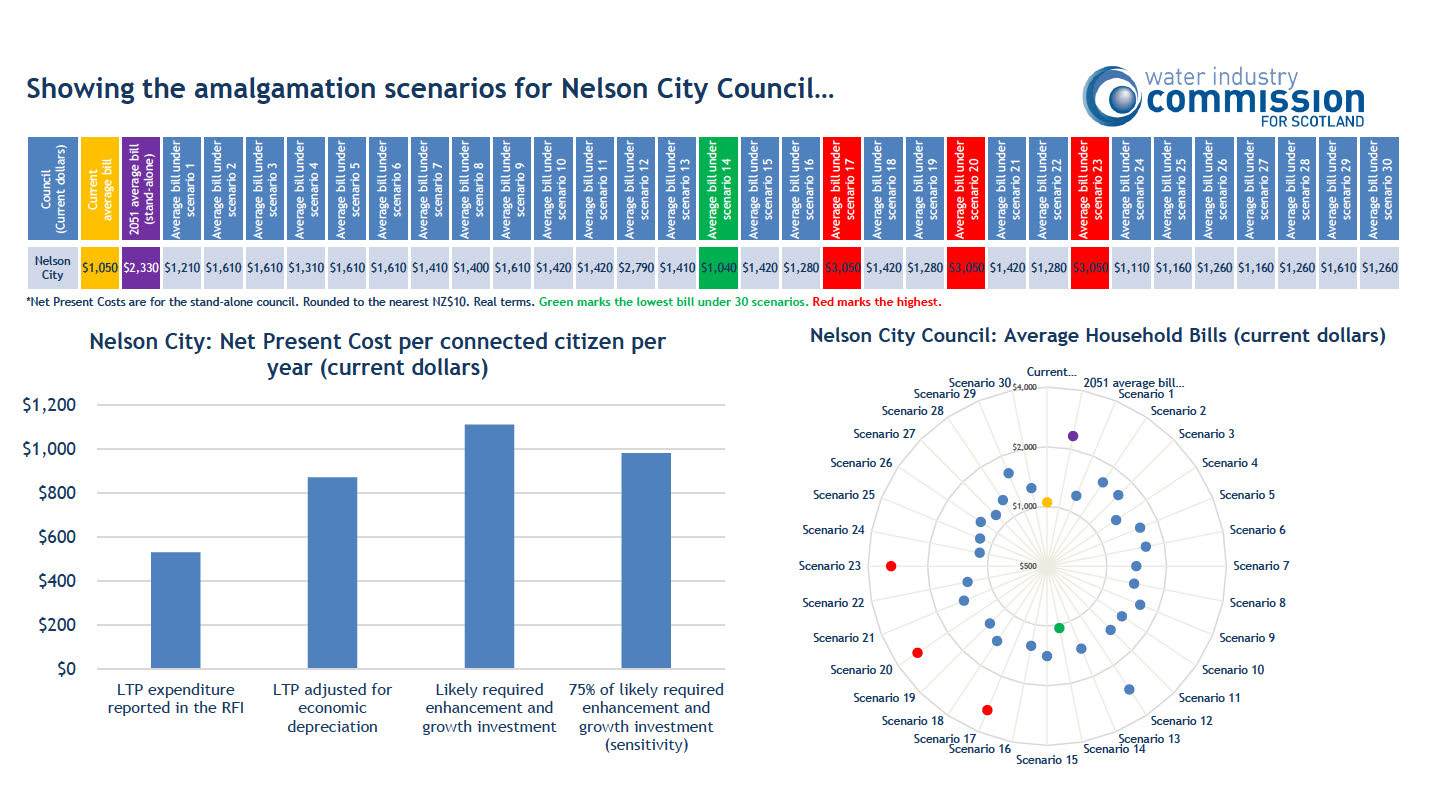
the Act
under
Information
Released
Official
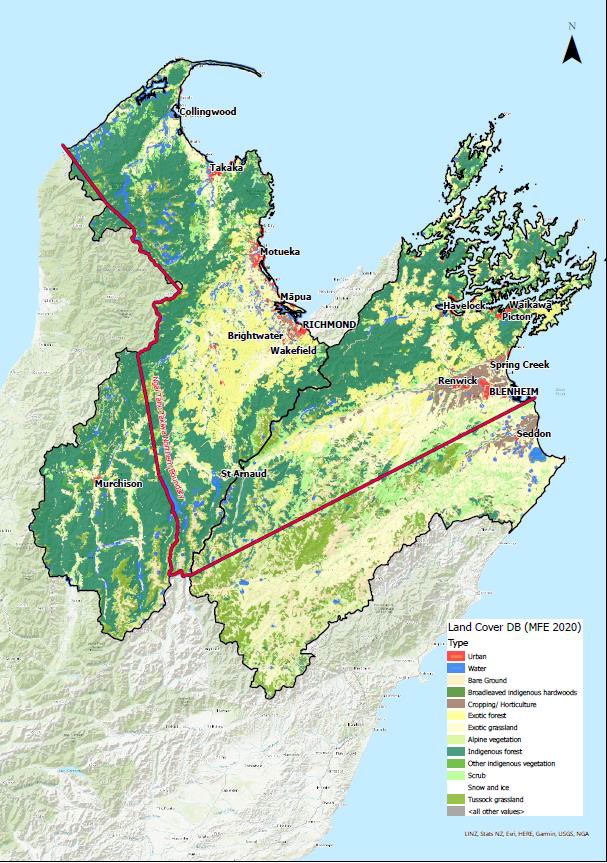
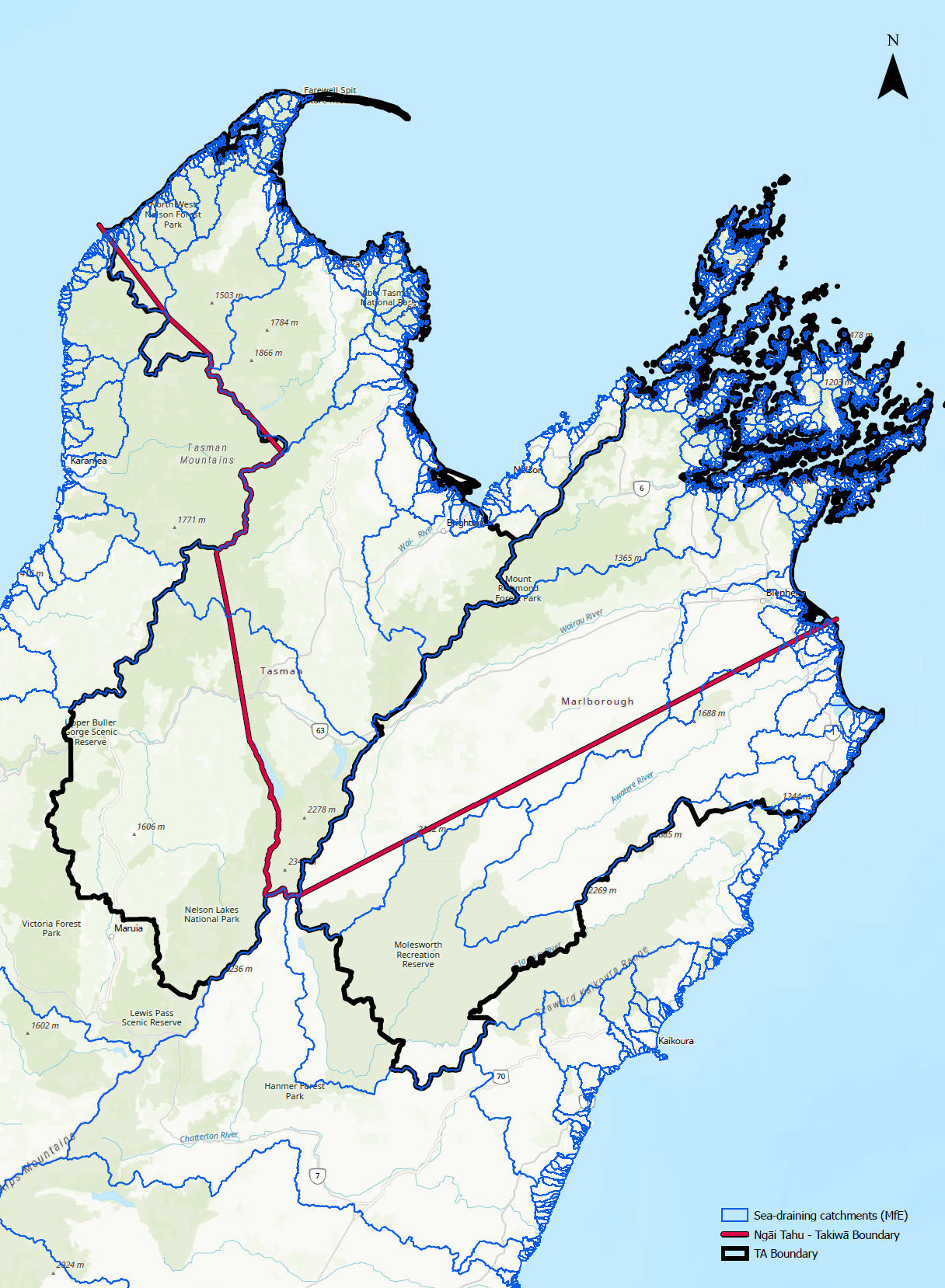
the Act
under the
under
Information
Released
Official Information Act
Official
1

































